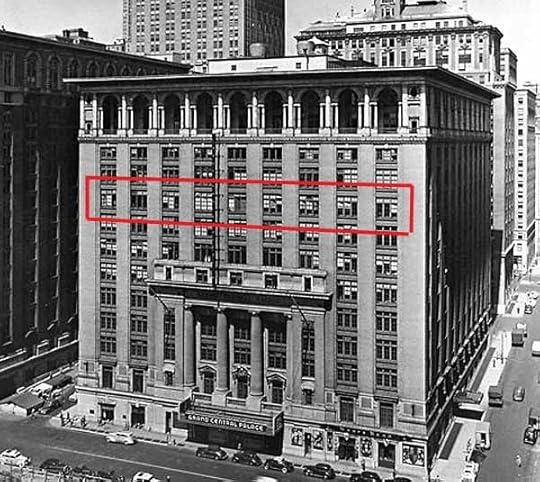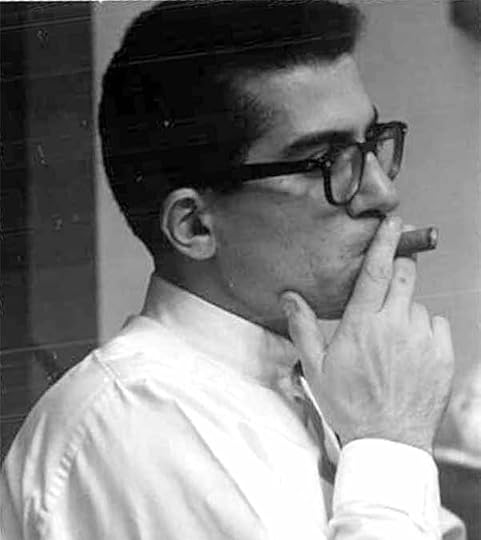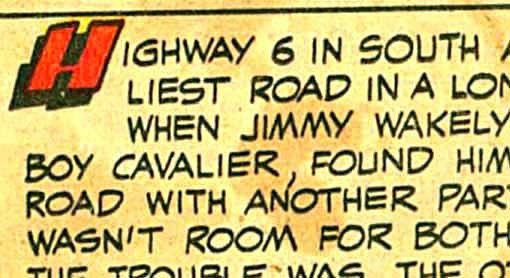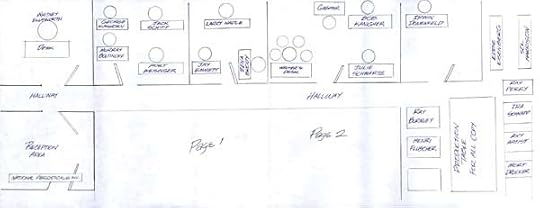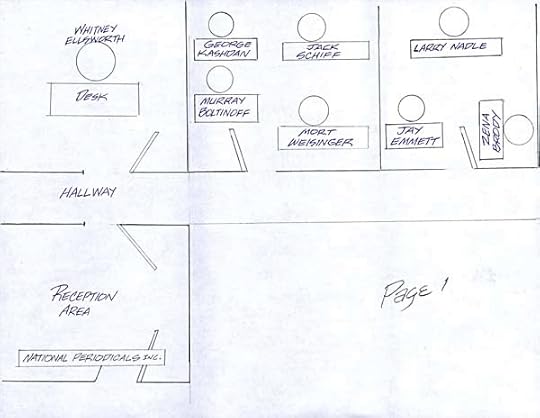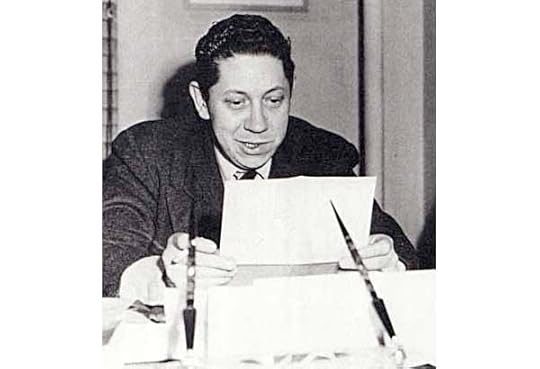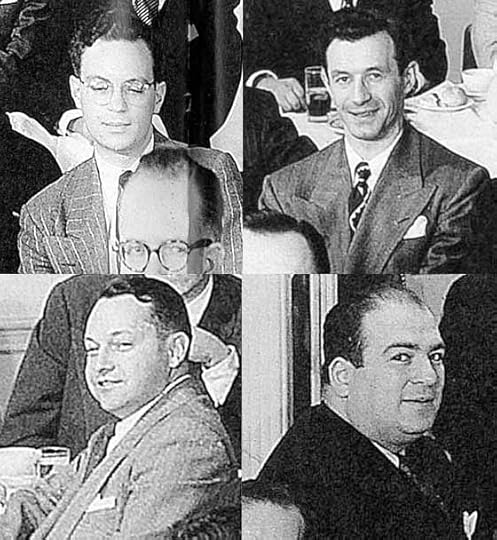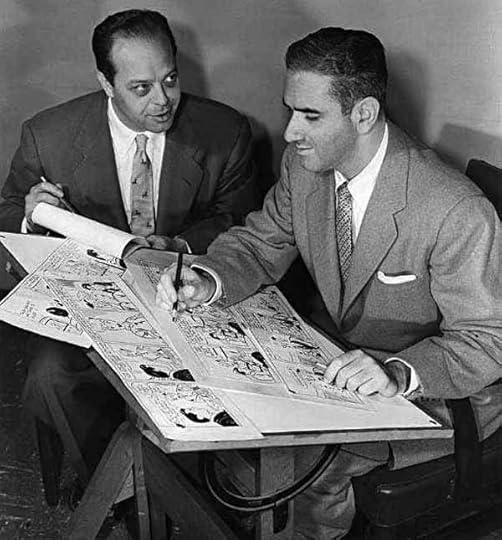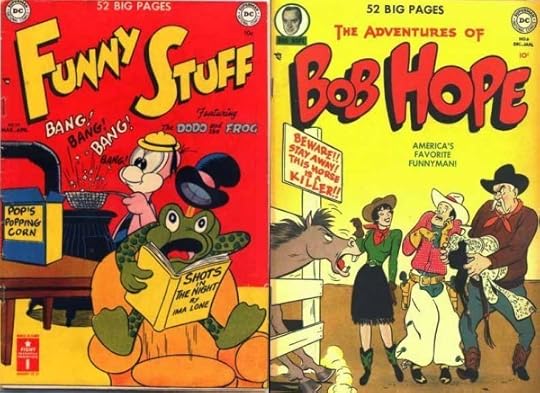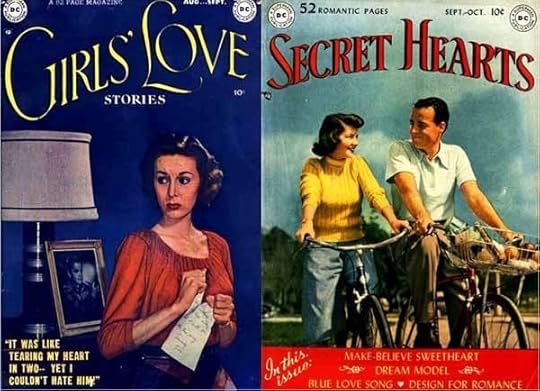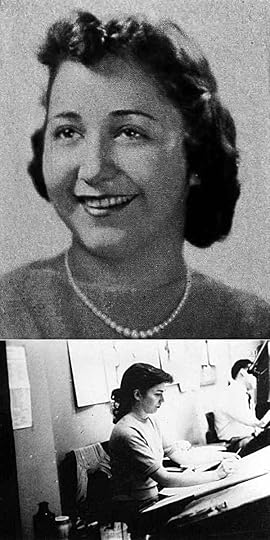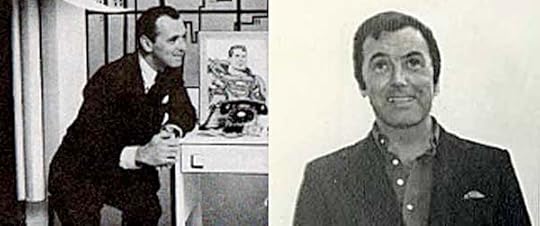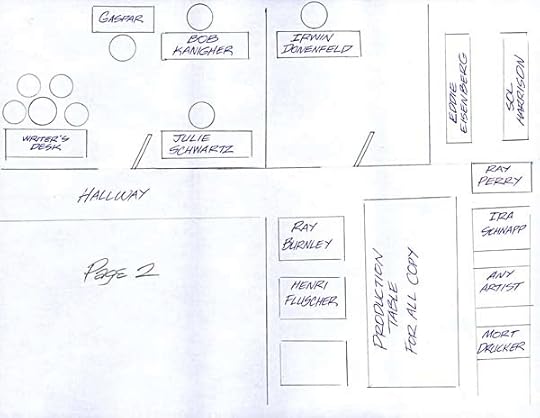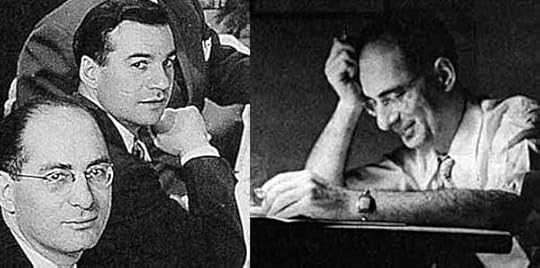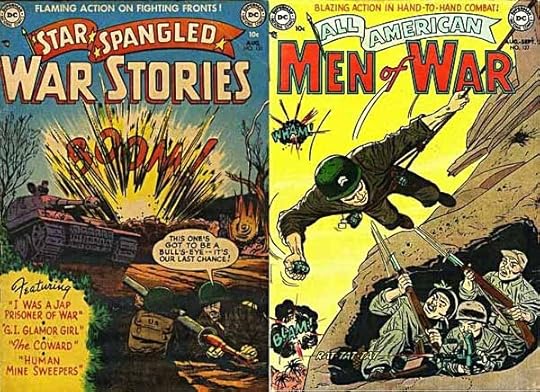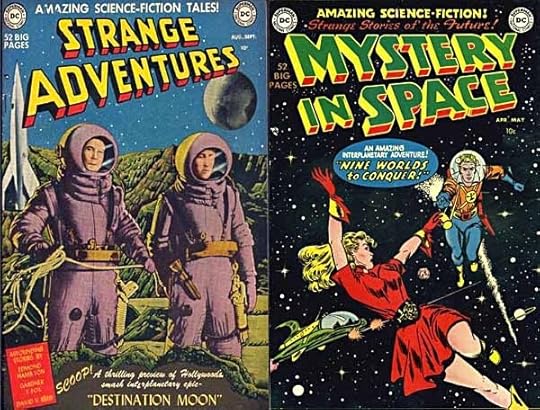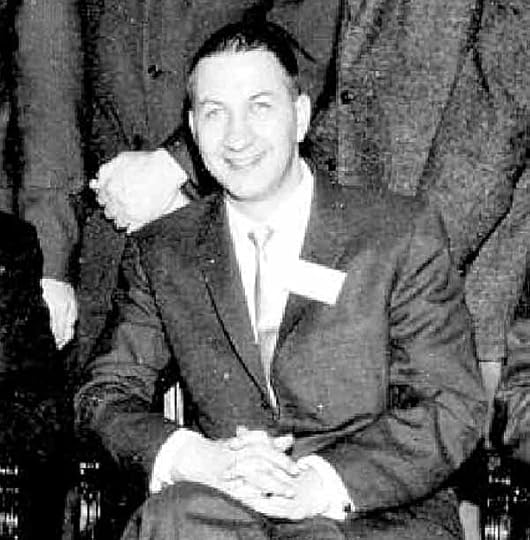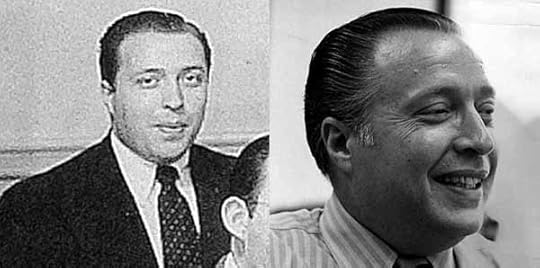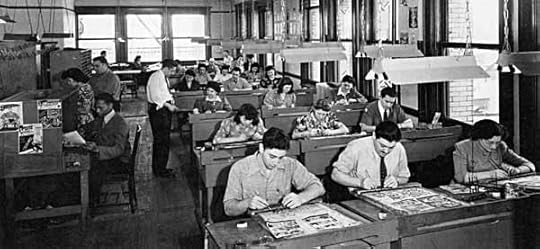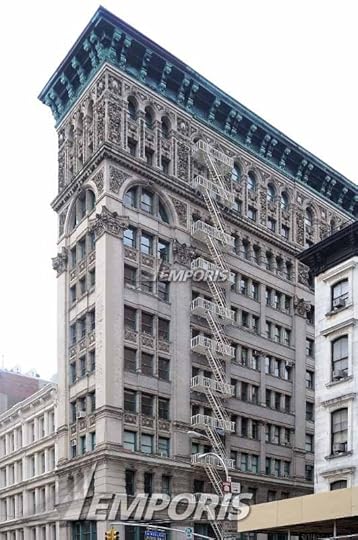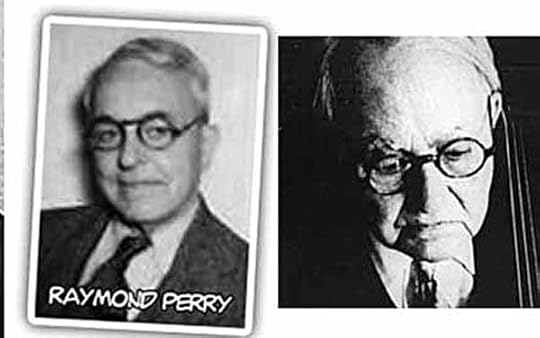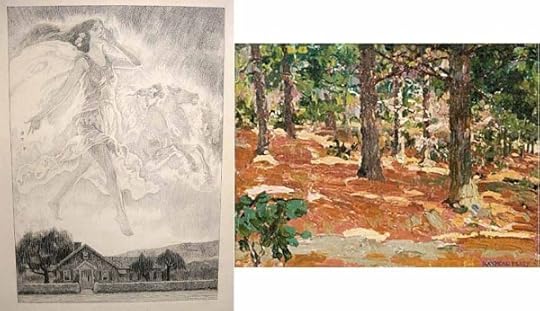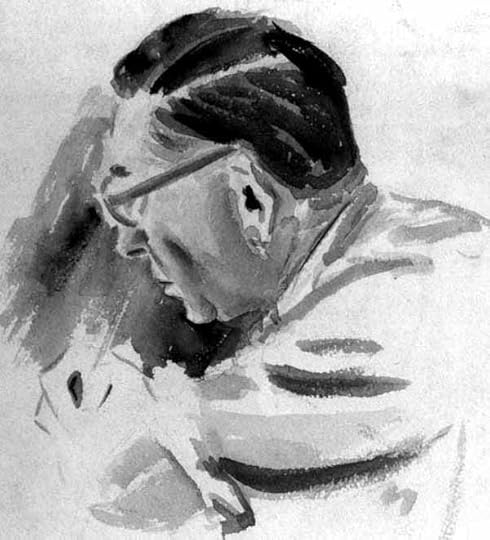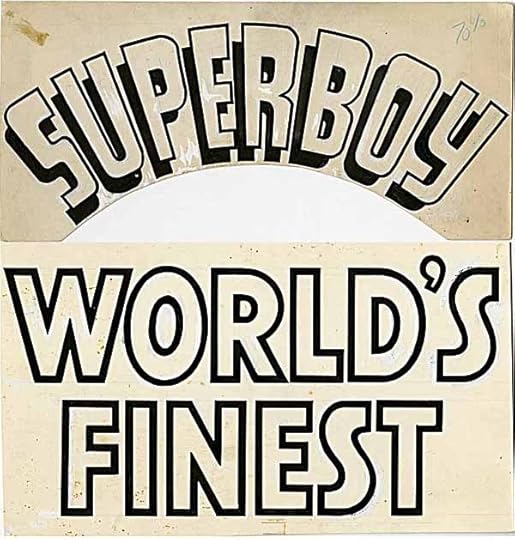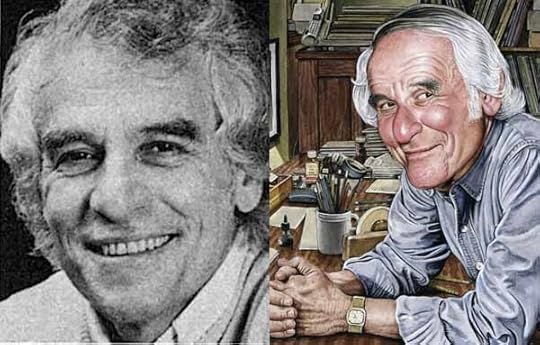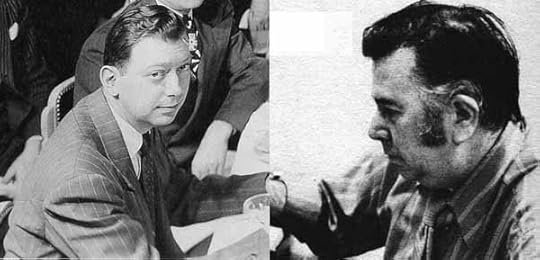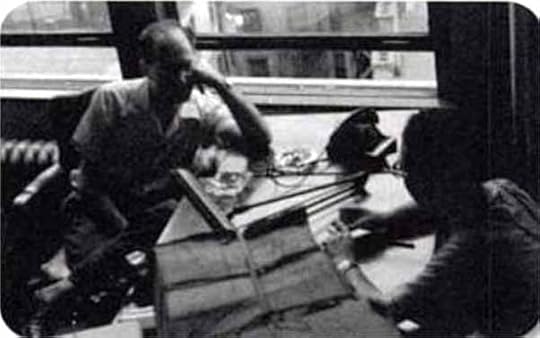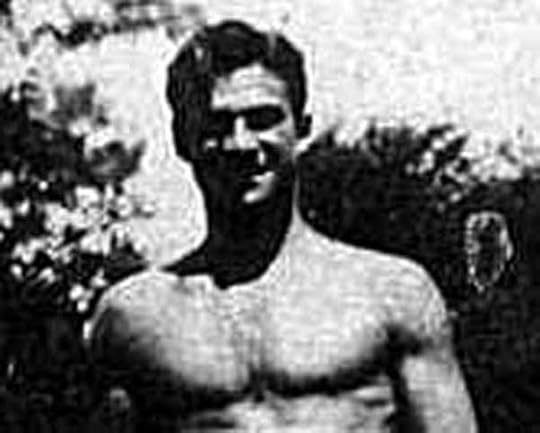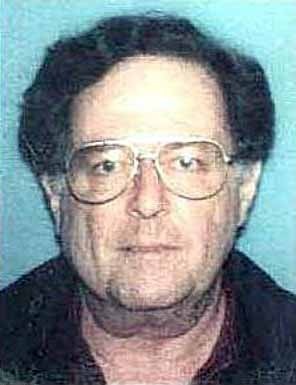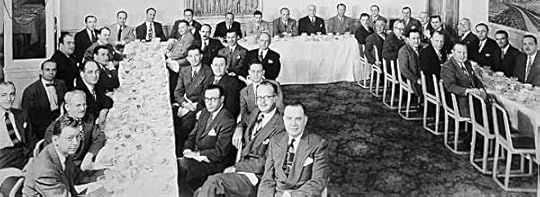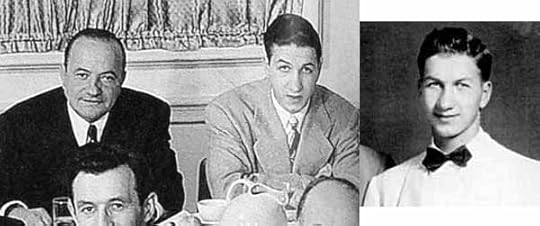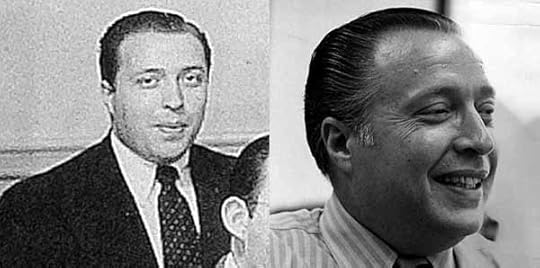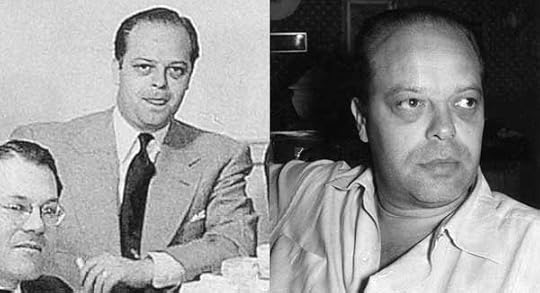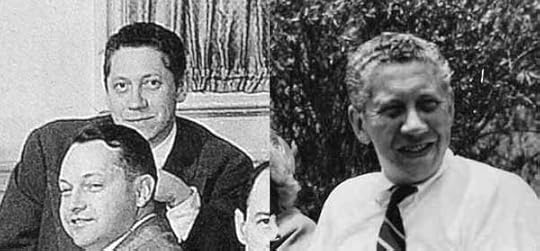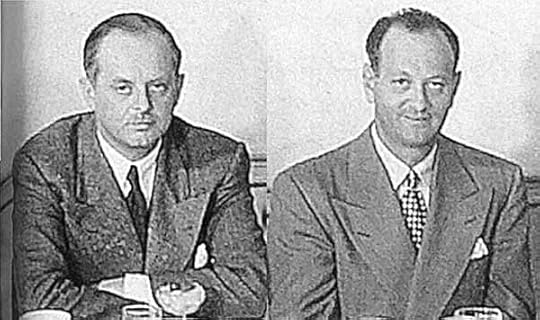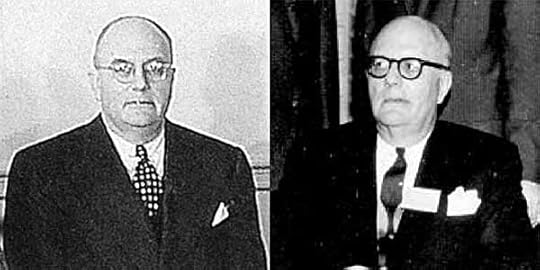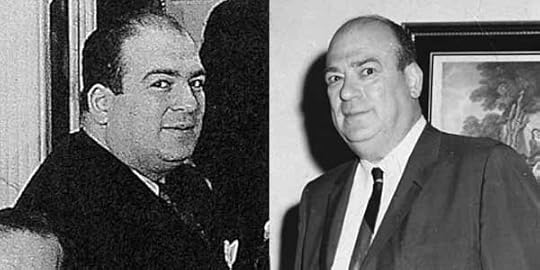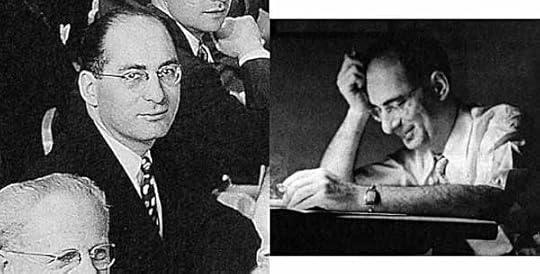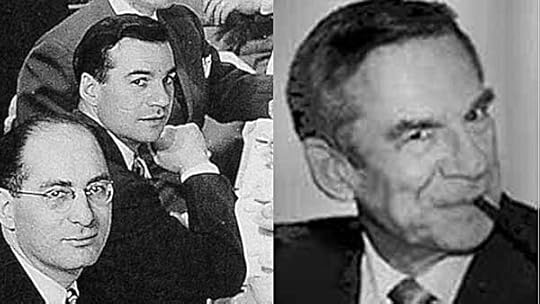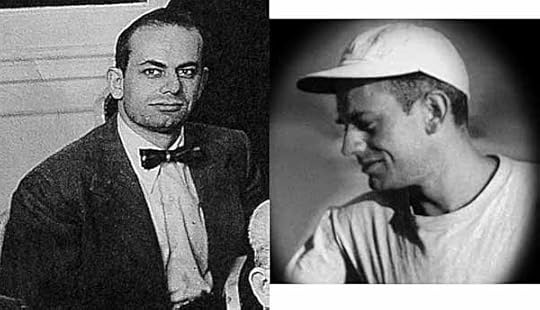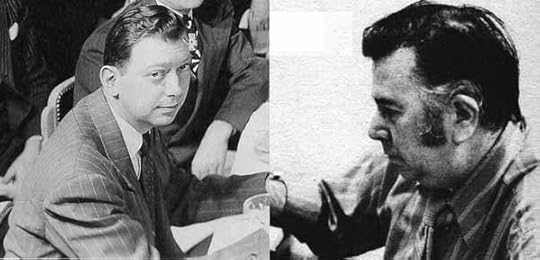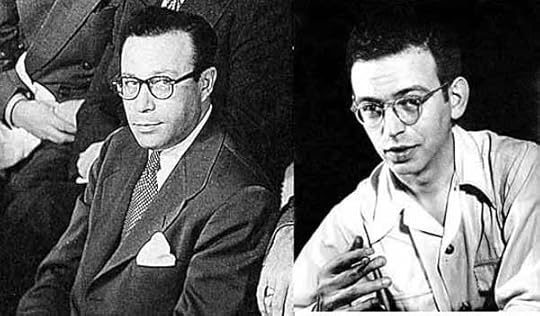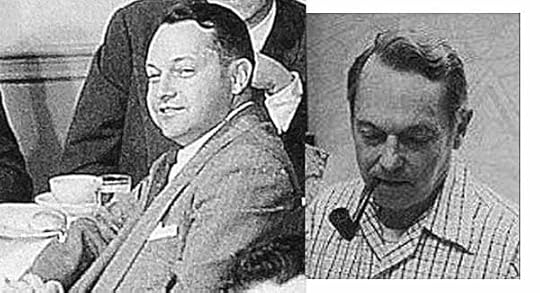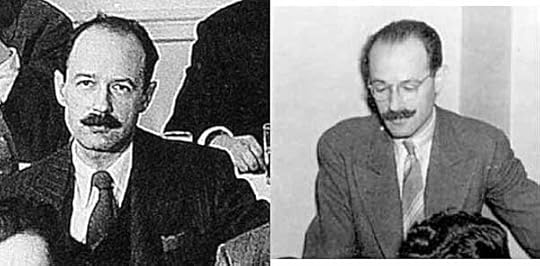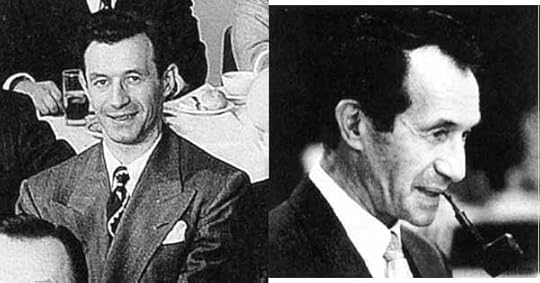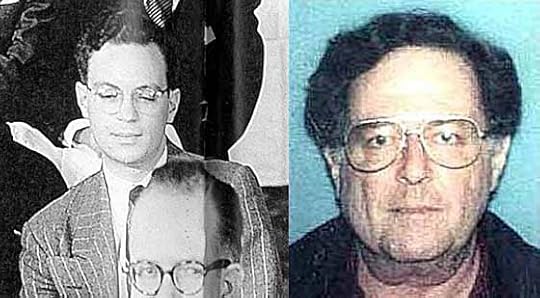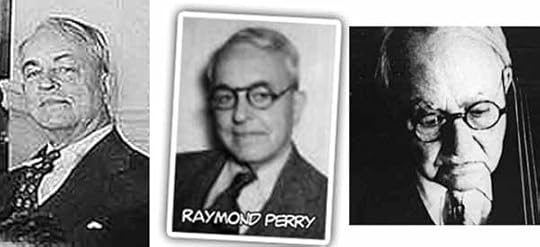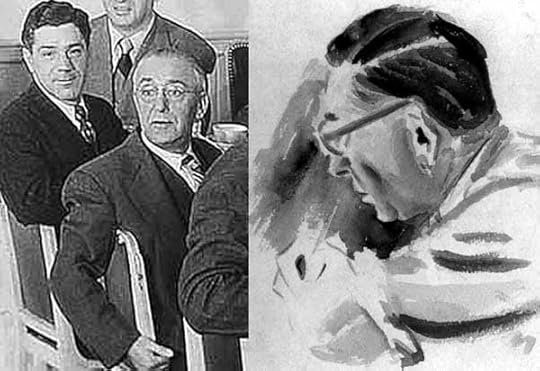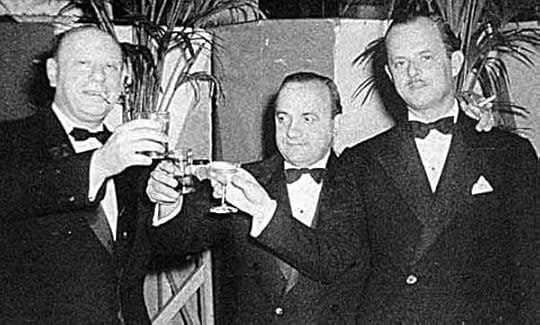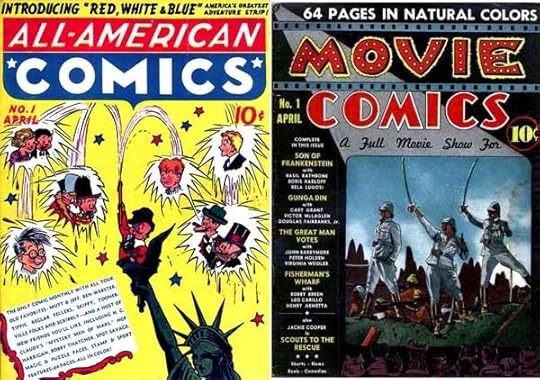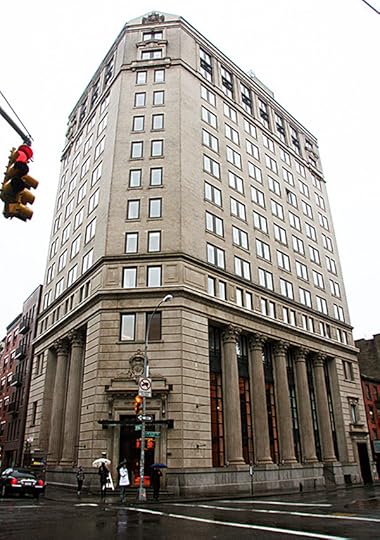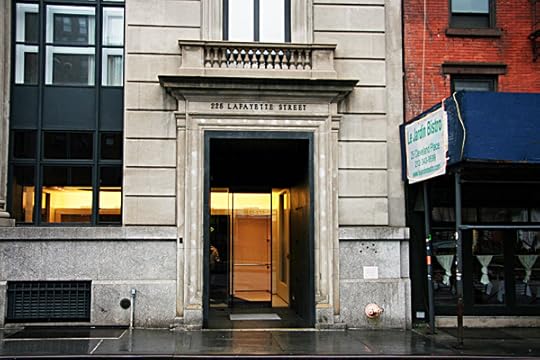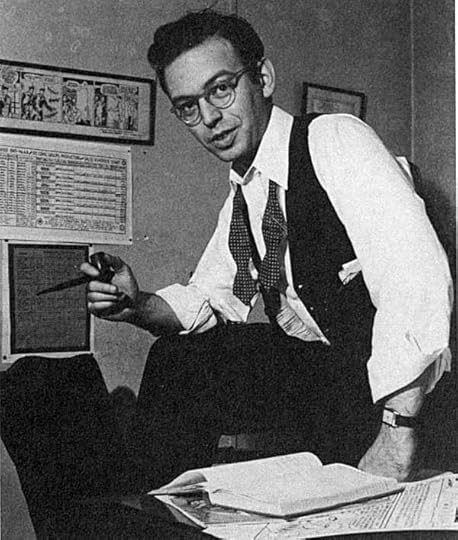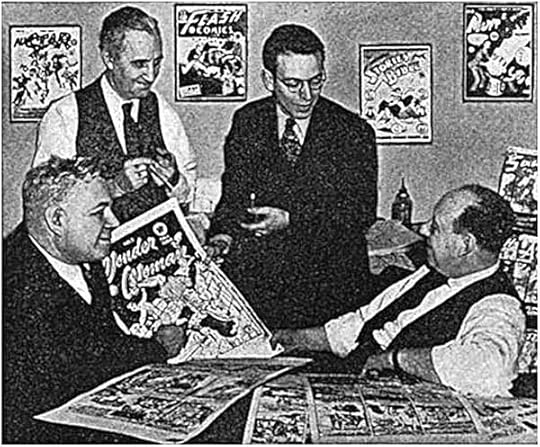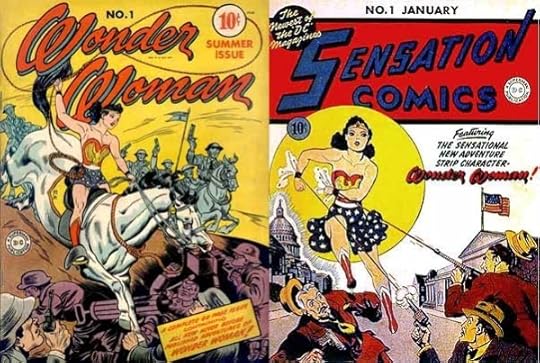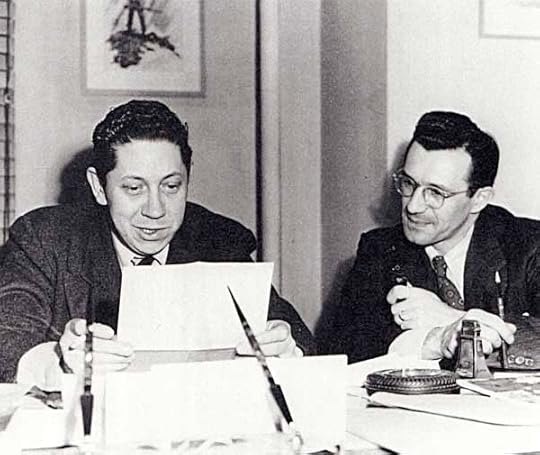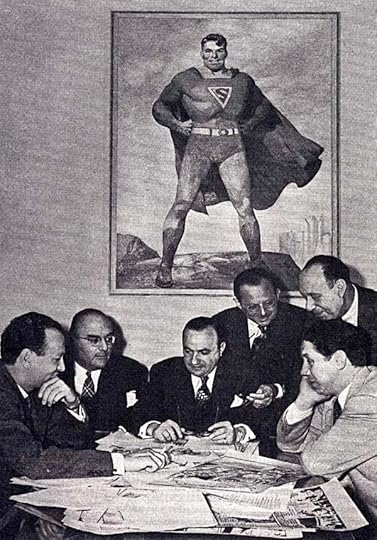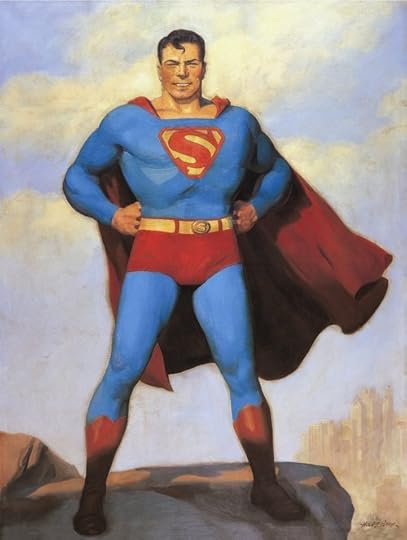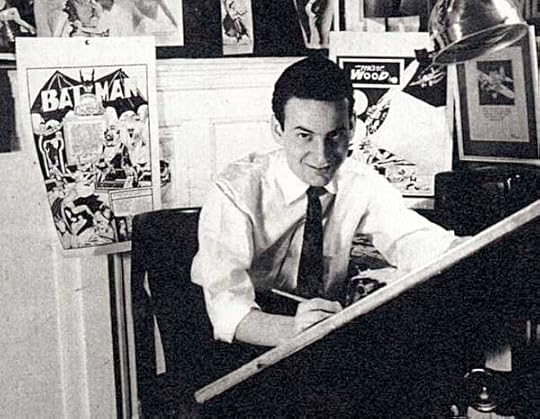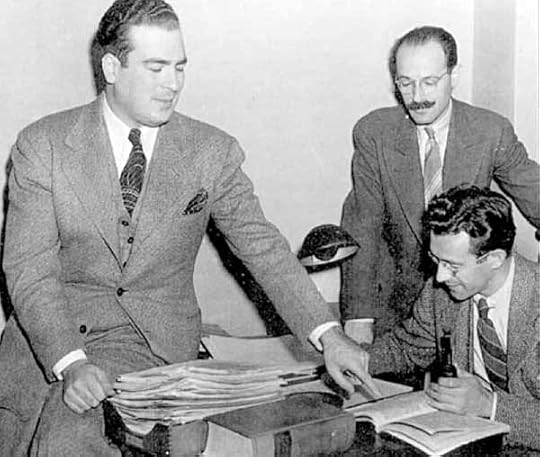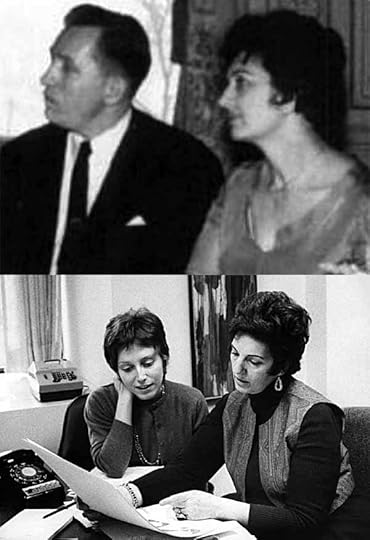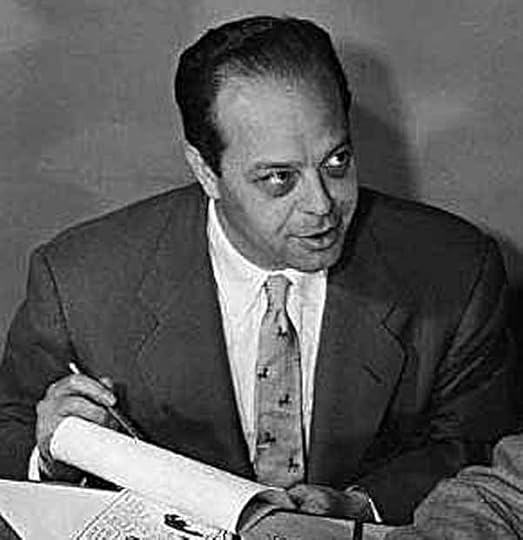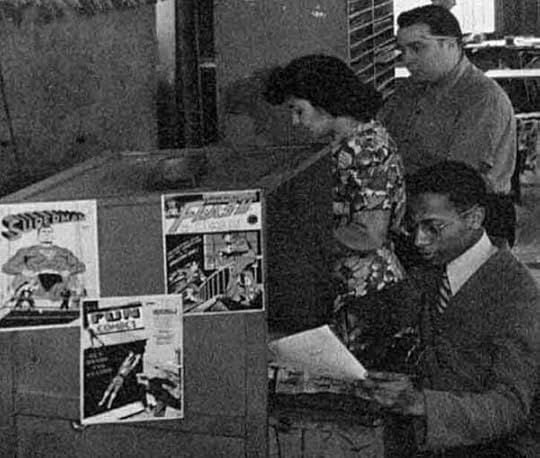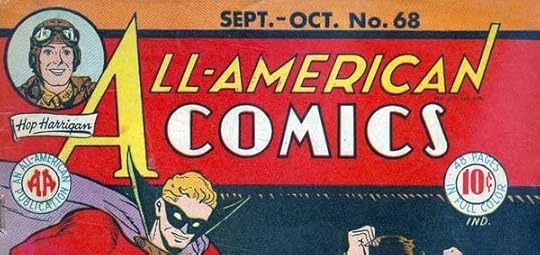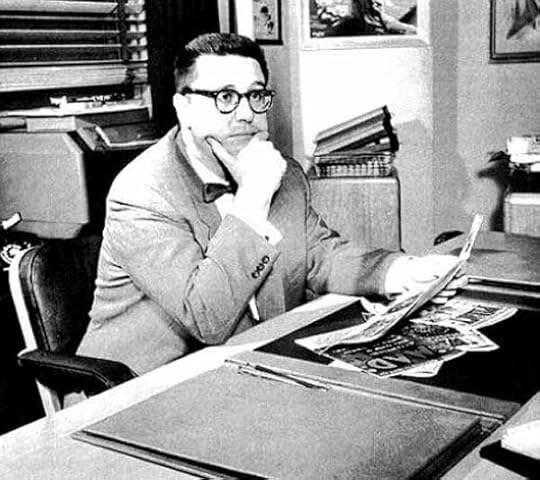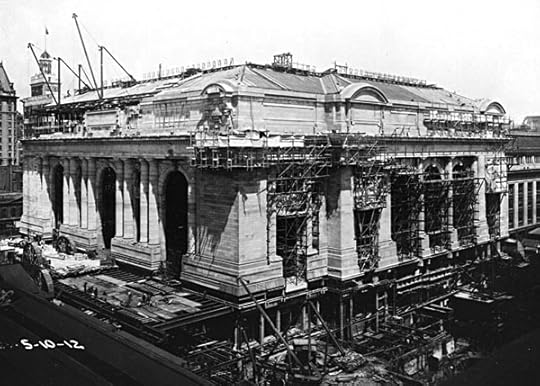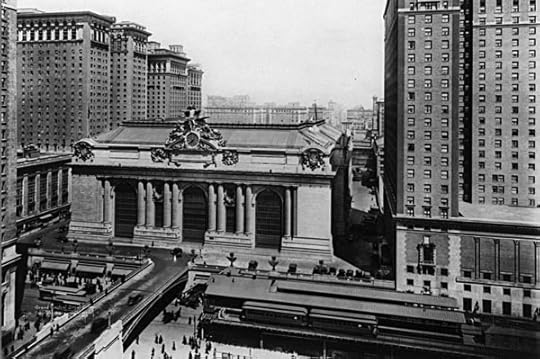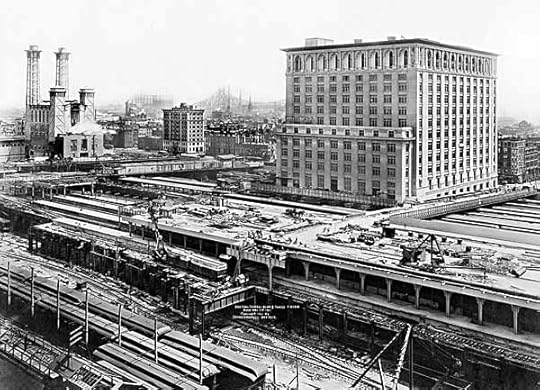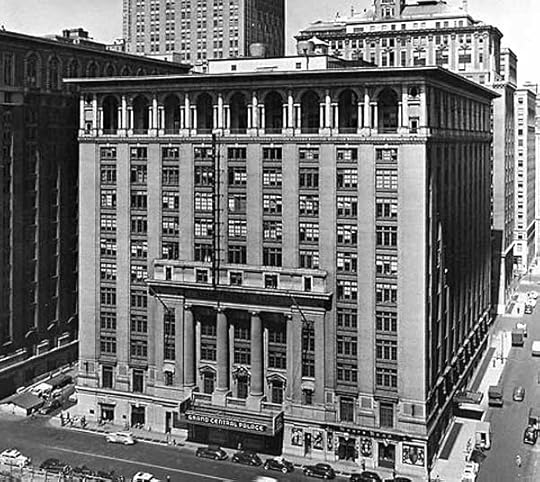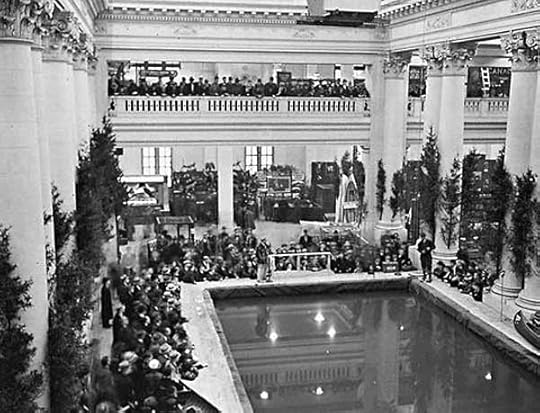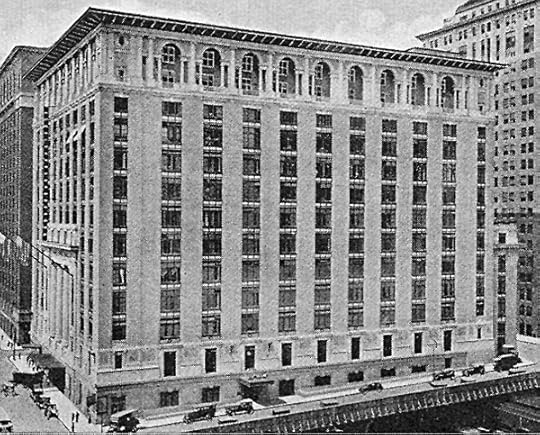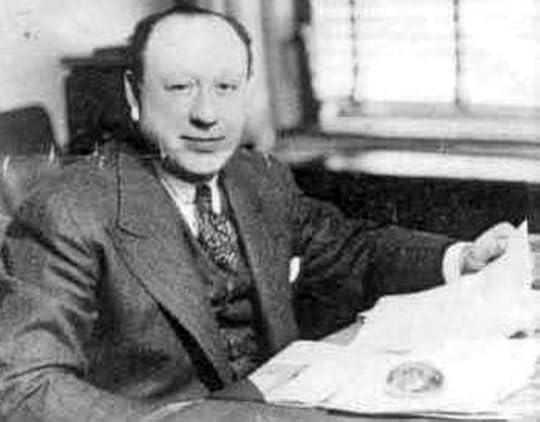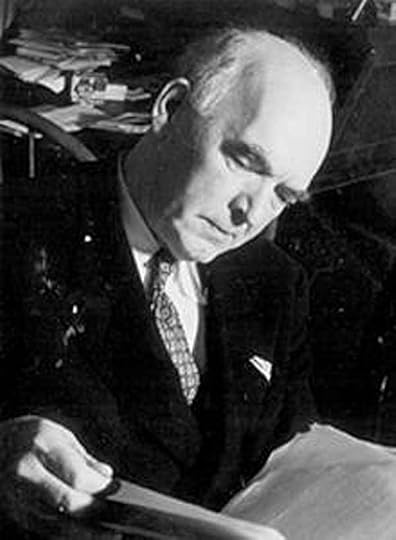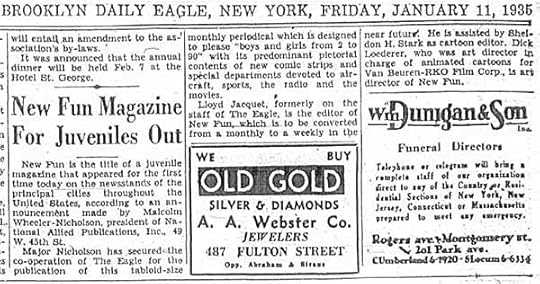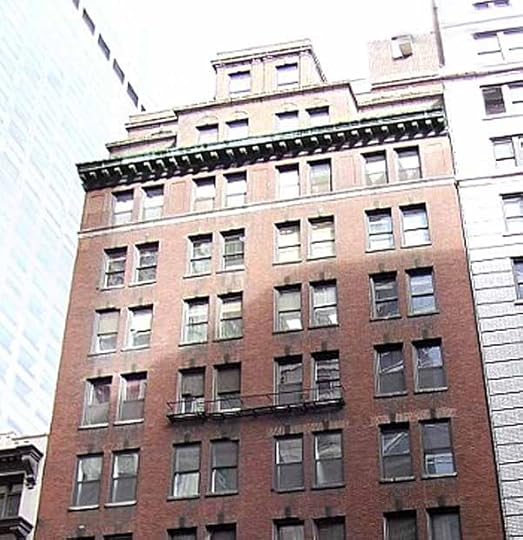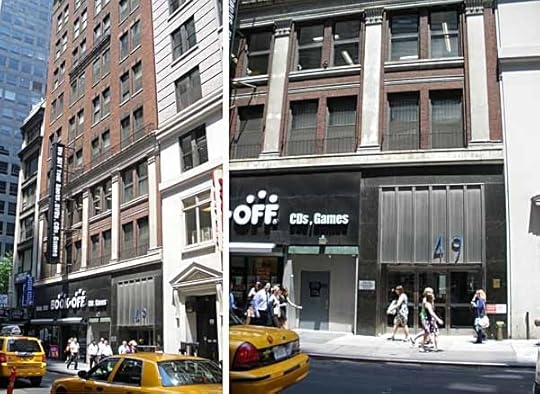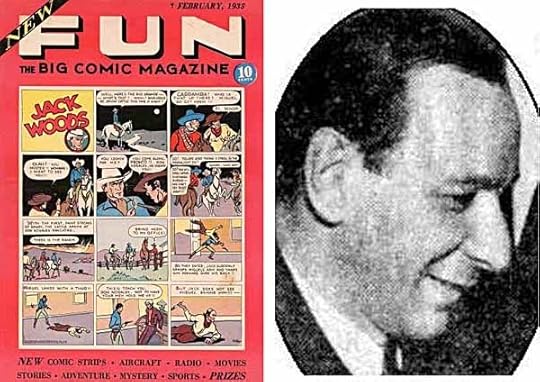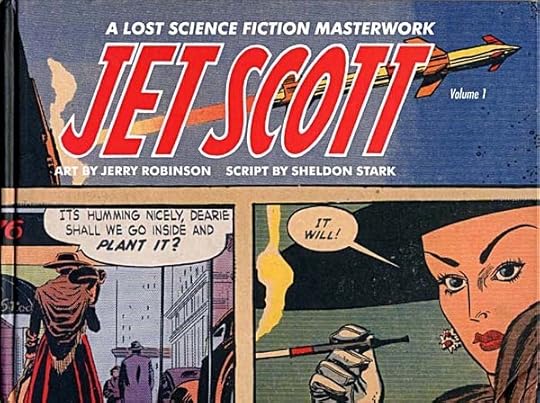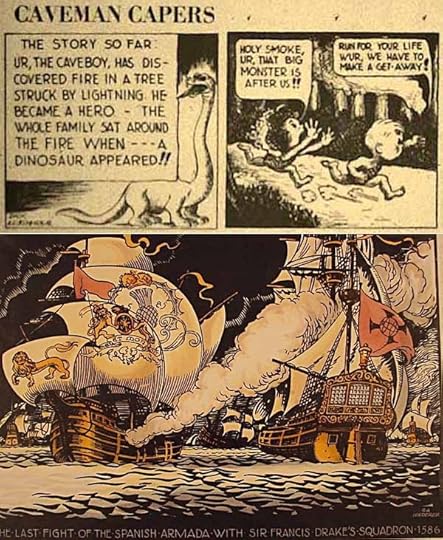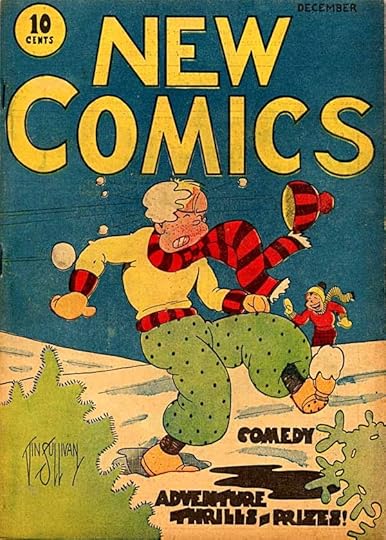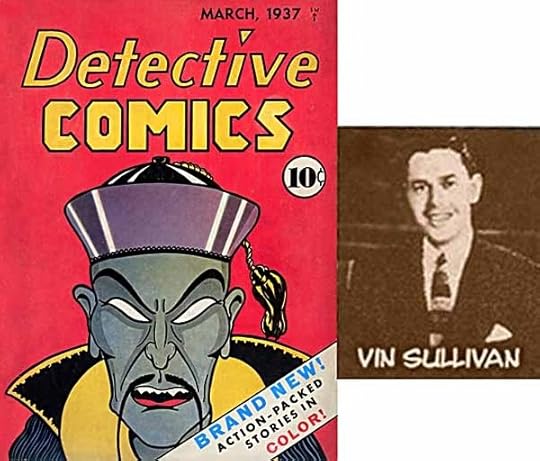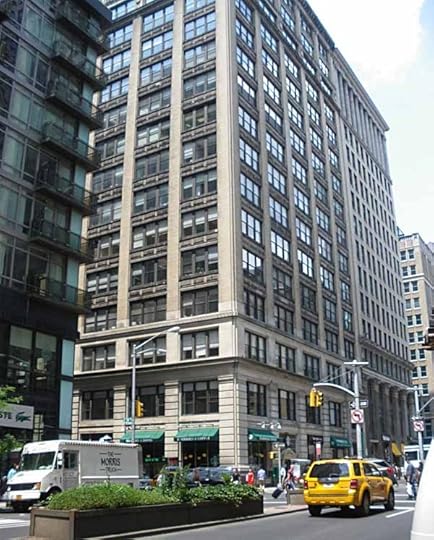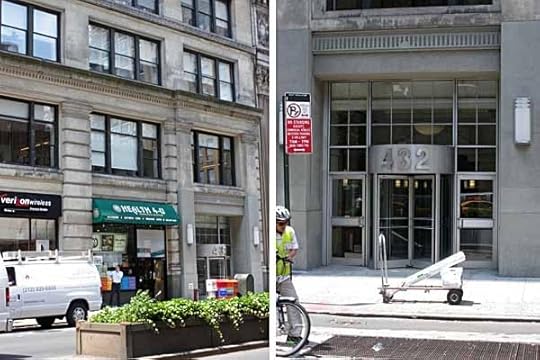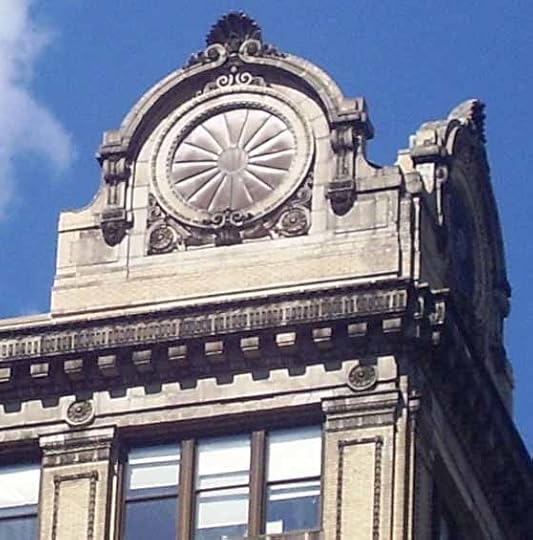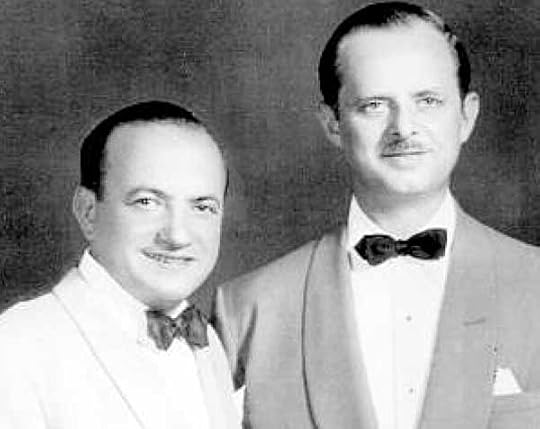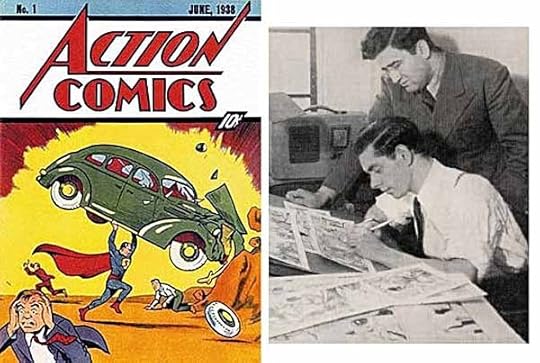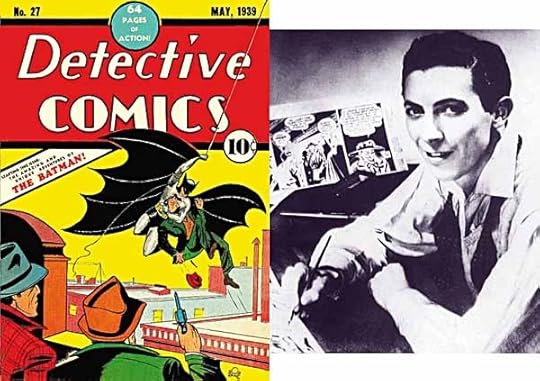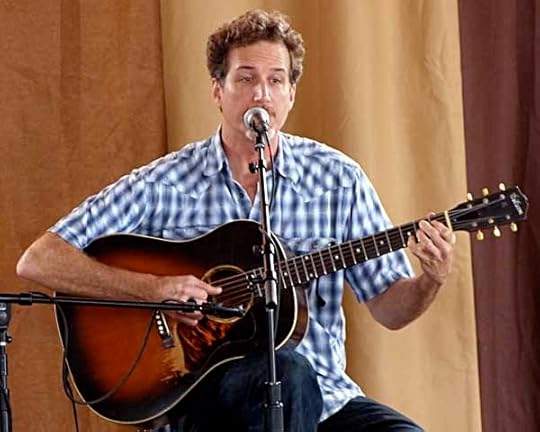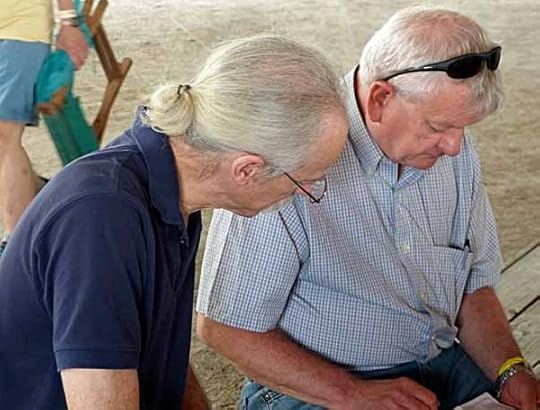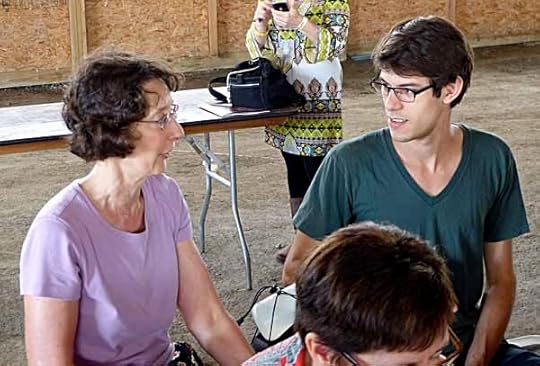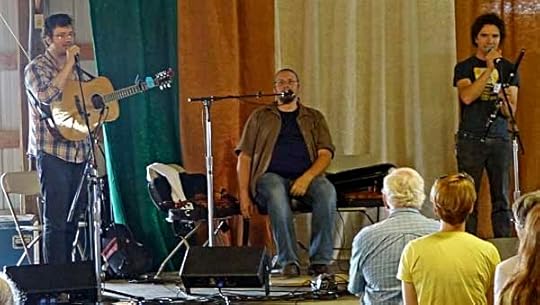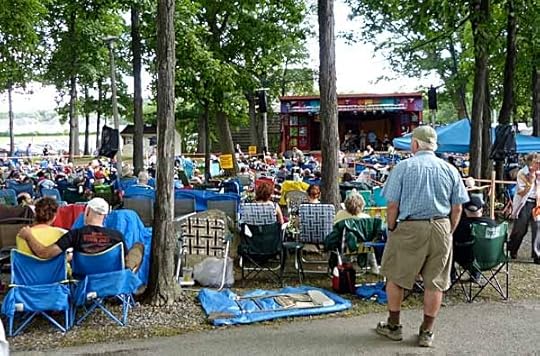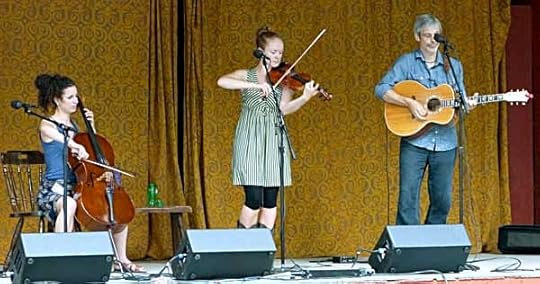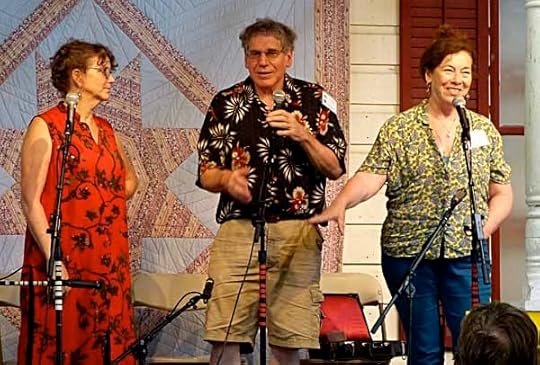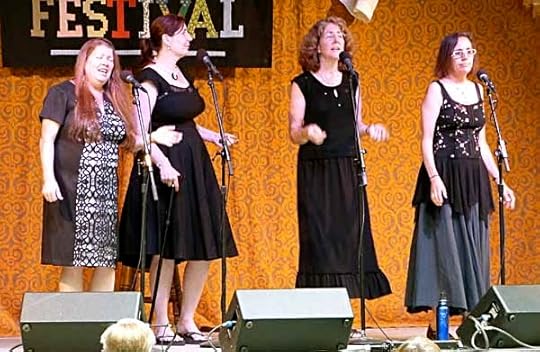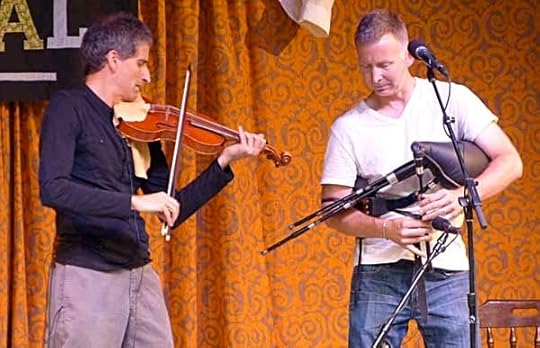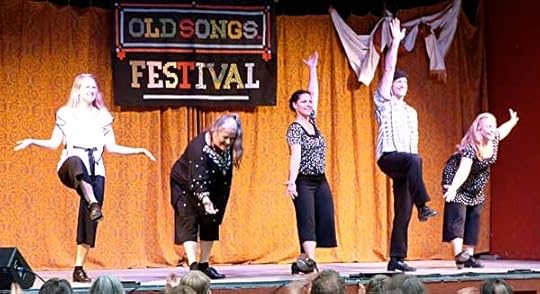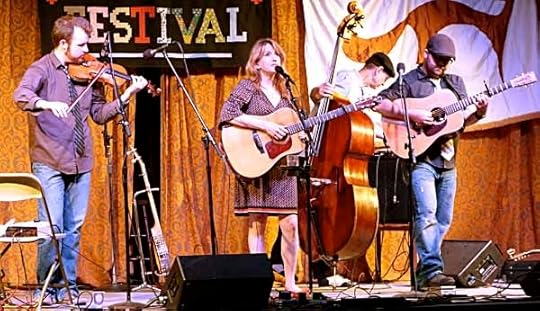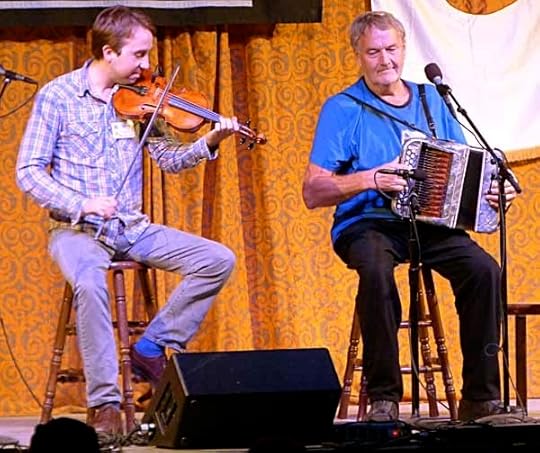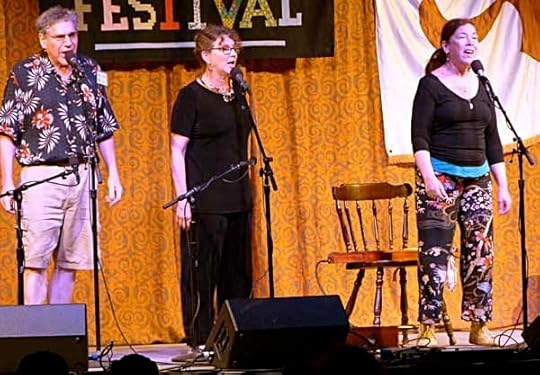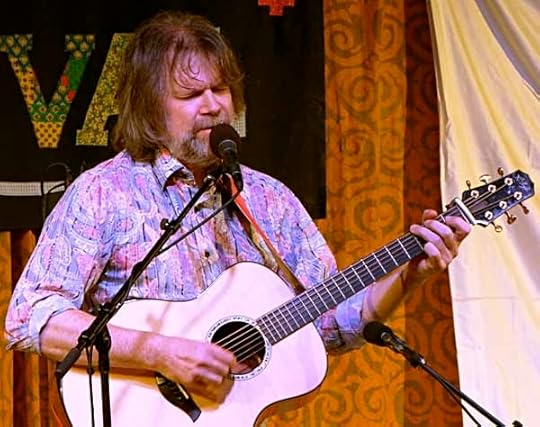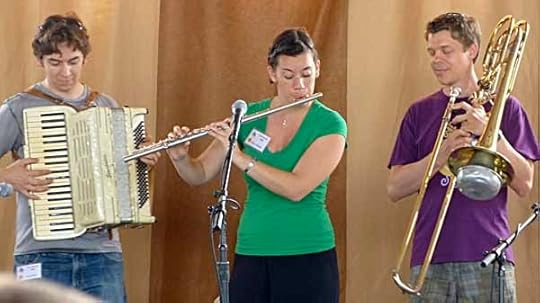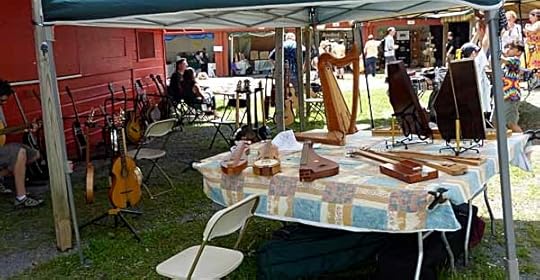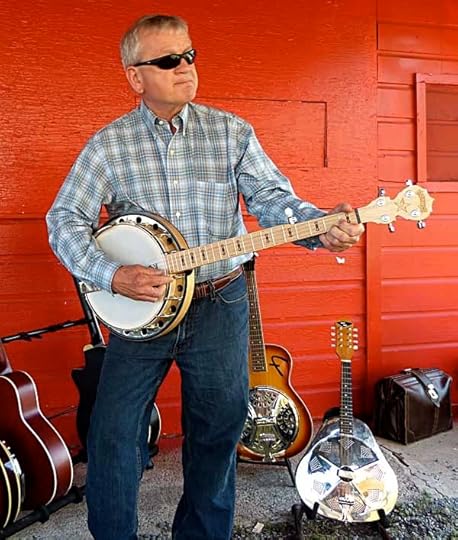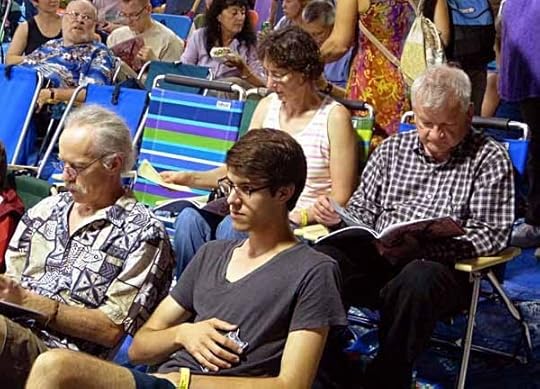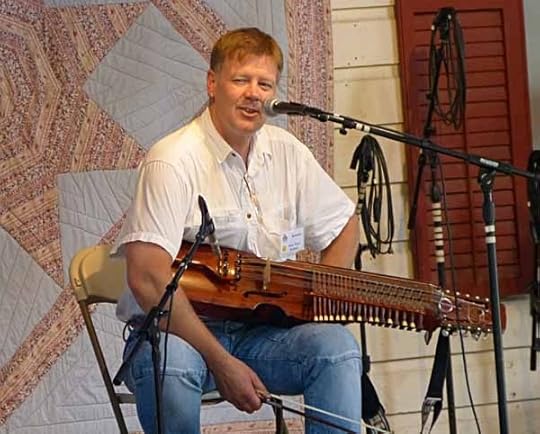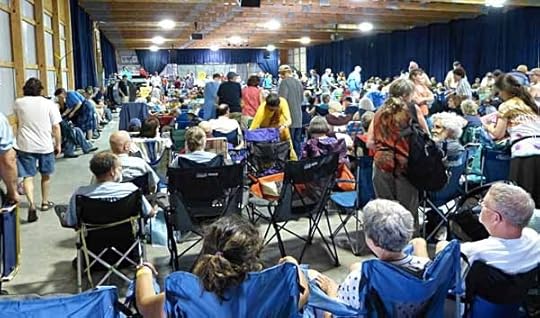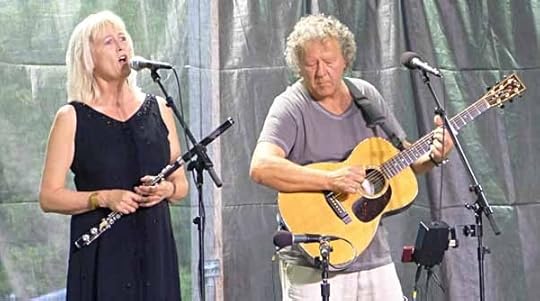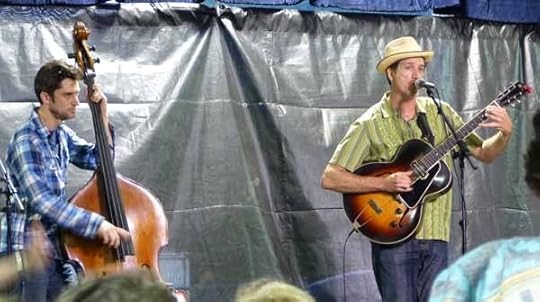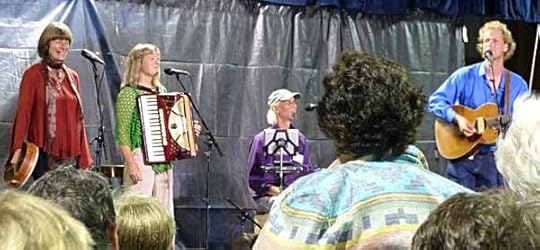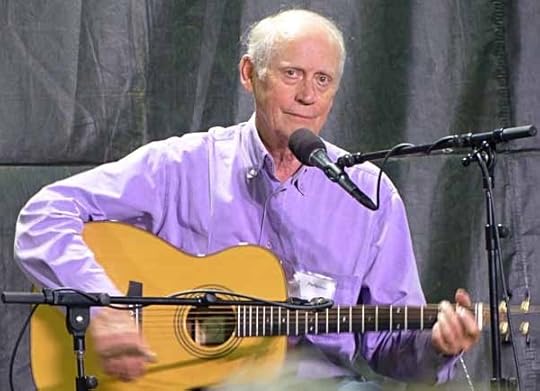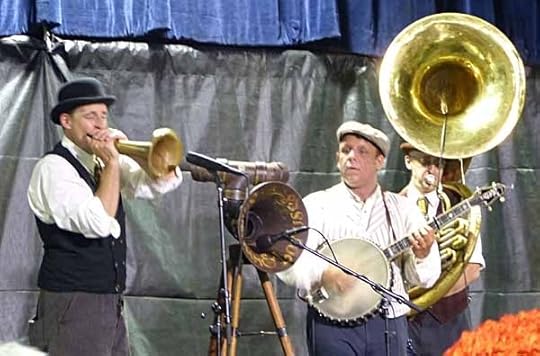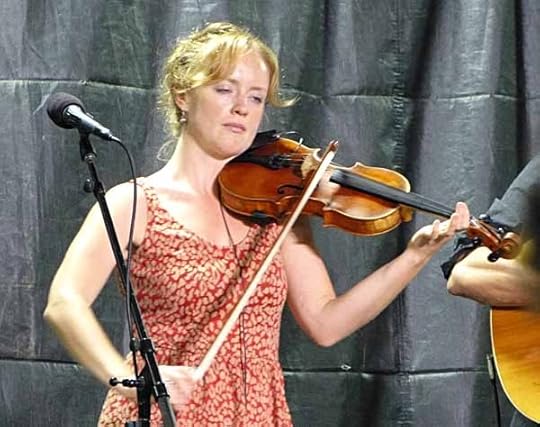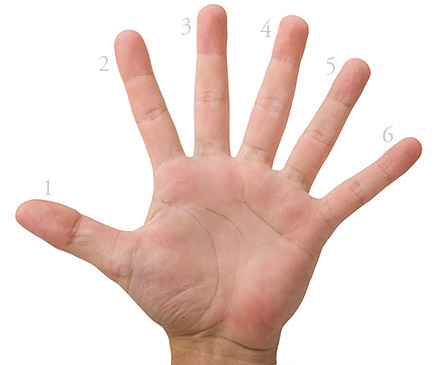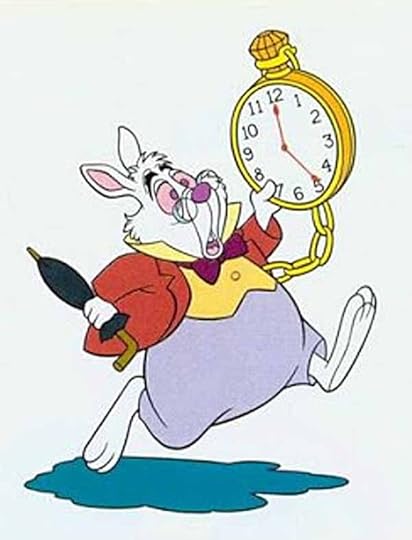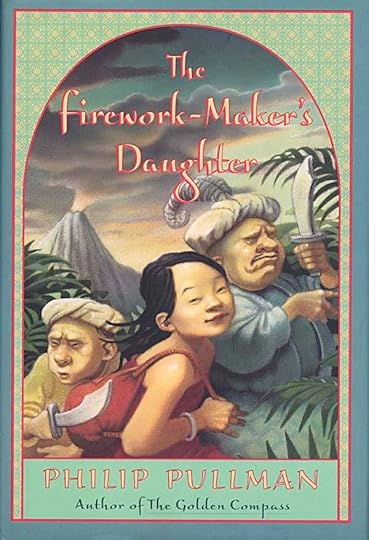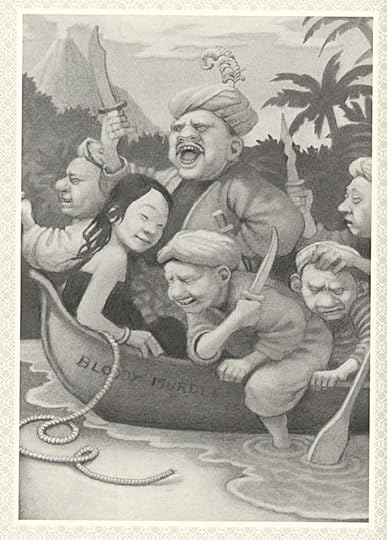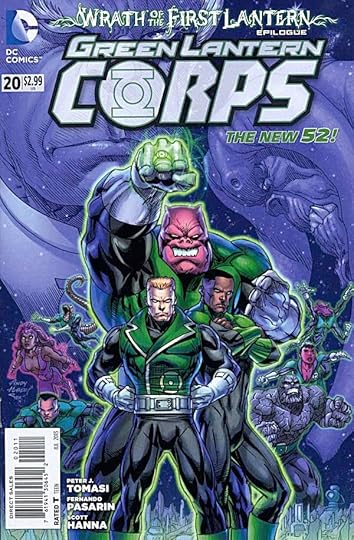Todd Klein's Blog, page 273
July 11, 2013
The DC Comics Offices 1930s-1950s Part 4
Grand Central Palace, business address 480 Lexington Avenue, with 9th floor windows indicated. Photo: Uris Buildings Corporation.
In 1950, the offices of National Comics Publications, also sometimes known as Detective Comics, Inc (and incorporating the former All-American Publications) had been inhabiting offices on the ninth floor of the Grand Central Palace building for about twelve years. The company’s comics had sold like crazy from the late 1930s through mid 1940s with their characters Superman, Batman and Wonder Woman leading the way, but after World War Two enthusiasm for super-heroes began to wane, and the company was trying all kinds of new genres and directions like westerns, romance, teen humor, Hollywood stars, crime and horror (the latter two much milder efforts than many other companies). Editors at the company were looking for ways to increase sales, and to do that they wanted more control over the product. The editors were already working closely with their writers, hammering out plots together so there would be no surprises, but the old method of turning over the script to an artist or shop boss and having them bring it back complete, already pencilled, lettered and inked, was not ideal. Editors like Julius Schwartz wanted to be involved in every step of the process: hiring the best writers, working with them on story plots and ideas, hiring a penciller right for each story, getting it lettered correctly, having it inked by the right person of their choice (whether for style or speed), and so on. In other words, the job was being divided up, with editors having more say and control over each part of the process. To help with this, Julie desperately wanted an in-house letterer he could work with directly on his books. He found one in Gaspar Saladino.
Gaspar Saladino, 1950s, photo courtesy of his daughter, Lisa Weinreb.
Gaspar has long said that he began working at National (DC) Comics in 1951, but in a lengthy article beginning HERE, my research showed his first lettering for editor Julie Schwartz appeared in ROMANCE TRAIL #5 cover-dated March-April, 1950. Since that issue actually appeared on the newsstands around January of 1950, that meant Gaspar must have lettered it in 1949, perhaps in October or November of that year. Gaspar was 23, and a graduate of the School of Industrial Art (later the High School of Art and Design) in Manhattan, class of 1945. He served in the Army for two years, and by 1947 was home pounding the pavements, looking for art jobs. He had done some inking work for Lloyd Jacquet’s shop in high school, but had no other comics experience. Some of his high school classmates like Alex Toth and Carmine Infantino were working for National, though, and he did up some sample art pages and took them to the offices at 480 Lexington for an interview. He saw production manager Sol Harrison (himself a graduate of that same high school, and always friendly to other alumni), who took his samples around to show the editors. Julie Schwartz said he didn’t like Gaspar’s art enough to hire him for that, but he did like his lettering, and offered regular lettering work, which Gaspar was glad to get.
From JIMMY WAKELY #7, © DC Comics, Inc.
Gaspar claims he had never done any comics lettering until those samples, but his earliest stories in ROMANCE TRAIL #5 show he came to the job with lots of talent, and only improved over the next few months. Above is an example from JIMMY WAKELY #7, cover-dated Sept.-Oct., 1950, already showing his firm hand and excellent style.
Julie wanted Gaspar to work in the office so he could have more control over the lettering, and get corrections done quickly. Julie had been getting some in-house lettering help from two high school students, one named Arthur Secunda (Gaspar doesn’t remember the other name), but otherwise this was a new situation at the company, except for the case of Ira Schnapp, who was doing most of the logos, cover lettering and house ads (and I believe had only been on staff himself for about a year). At first, Gaspar sat at a drawing board in the production room or bullpen between Ira Schnapp and production artist Mort Drucker, but after about a month, he moved to a drawing board right in the office shared by Julie and Robert Kanigher, and worked there for some years. Gaspar was still technically a freelancer, working for $2 a page, but he was required to be in the office from 9 to 5 Monday through Friday, like the rest of the staff. At the end of the week he’d submit a voucher for his work, on average nine pages a day or 45 pages a week, and get paid. The pages were often full of copy, lots of captions and balloons, which is why they took that long to letter, but $90 a week was good pay at the time, and Gaspar was quite happy with the arrangement. His talent pleased everyone he worked for, and Saladino lettering was soon in high demand at National Comics.
Gaspar is still pretty sharp at age 86, and he and I have been talking more in the past year than we did for a dozen years previously, about the article I’ve just described, as well as some new lettering and a new logo design he’s completed recently. I’ve been asking him regularly to draw me a floor plan of the offices at 480 Lexington Avenue as he remembers them from when he started working there, and at last he came through, and mailed it to me. We’ll discuss it next.
480 Lexington Avenue floor plan images © Gaspar Saladino.
The plan is drawn on two standard pieces of typing paper, in this first image I’ve combined them to give an overview of the entire layout. Note that the blank areas where he’s written Page 1 and Page 2 were not part of the comics offices, probably other businesses accessed from the outside hallway. Gaspar says that as you entered the building (probably through the smaller side entrance in the top photo above) you came to the elevators and went up to the ninth floor. As the elevator doors opened you were looking directly at the offices of Harry Donenfeld and Jack Liebowitz. There was a receptionist for the entire floor at that location. Donenfeld’s other companies like Independent News were on the floor somewhere, but you walked down a long hallway to the National Comics entrance. Gaspar remembers the windows in the editors’ offices, at the top of this floor plan, faced Lexington Avenue, or the east side and main facade of the building. I’ve circled those windows in red on the top photo above.
Here’s a closer look at the left side of the layout. The long hallway would have been at the bottom of this page. I’m going to assume this is the layout in 1950. Gaspar has the entrance marked “National Periodicals, Inc.,” but Paul Levitz tells me that name was not used until the 1960s. The company was known as National Comics, Inc. at this time, I believe. You entered the reception area, which Gaspar remembers had a couch and a large mural of Superman on one wall. Not shown next to the entrance to the hallway was a glass window. A receptionist sat there (perhaps where the left end of the hallway is) and would take names and appointment information from visitors, or buzz in employees. She was also the switchboard operator for the offices, taking calls and directing them to the office phones, a typical setup for a receptionist at the time.
Whitney Ellsworth, 1940s, from “The Golden Age of DC Comics” by Paul Levitz, published by Taschen. © DC Comics.
Once into the hall, the editors’ offices ran along the left side, much as described by Julie Schwartz in Part 3 of this article. First was the office of editor-in-chief Whitney Ellsworth. Gaspar doesn’t remember seeing or talking to him much. By that time, Ellsworth was focused on Superman movies and the upcoming TV show, and would leave his New York staff position in 1953 and relocate to California as the company’s Hollywood liaison.
Kashdan (possibly), Schiff, Boltinoff and Weisinger from the 1948 staff photo in “The Golden Age of DC Comics” by Paul Levitz, published by Taschen. © DC Comics.
The second office held Managing Editor Jack Schiff and his three assistants, George Kashdan (replacing the recently deceased Bernie Breslauer), Murray Boltinoff, and Mort Weisinger, who also edited the Superman books on his own. While Gaspar’s drawing is not meant to be to scale, this looks like one crowded office! In addition to the Superman and Batman titles, these folks were editing some humor books, and new genre titles like MR. DISTRICT ATTORNEY and GANGBUSTERS.
Larry Nadle and Bob Oksner, early 1950s, publicity photo for the “I Love Lucy” comic strip, courtesy of Ken Nadle.
The next office held Larry Nadle, one of the former All-American editors whose specialty was humor comics.
FUNNY STUFF #59, THE ADVENTURES OF BOB HOPE #6, 1951, © DC Comics, Inc.
In addition to continuing to edit former All-American humor titles like FUNNY STUFF, Larry was soon adding Hollywood humor books like THE ADVENTURES OF BOB HOPE. Larry’s go-to artist on many of the latter was Bob Oksner, a partnership that continued on their side venture, the comic strip version of the “I Love Lucy” TV show which ran from 1952-1955, from King Features. The picture of Nadle and Oksner above has nothing to do with the National Comics offices, but it’s such a great one I couldn’t resist running it.
GIRLS’ LOVE STORIES #1, SECRET HEARTS #1, 1949, © DC Comics, Inc.
Romance comics were another popular genre, created by Joe Simon and Jack Kirby in the late 1940s with YOUNG ROMANCE and YOUNG LOVE for Prize Comics. National later bought those titles, but first launched some of their own. Robert Kanigher was the editor initially, but he soon had help.
Above, Eleanor Brody, University of Vermont yearbook, 1939. Below, Zena Brody in the National Comics production room, early 1950s, photo by Jack Adler, courtesy of Mike Catron.
Alex Jay and I, as well as Jerry Bails’ “Who’s Who of American Comic Books” think these two women are the same person. Eleanor Brody was born around 1920 in Brooklyn and studied journalism and writing at the University of Vermont from 1938 to 1941. Soon after that she was writing comics for the Iger shop. In a 2001 interview, Irwin Donenfeld says: “I hired a young lady named Zena Brody, and she put out four (romance) magazines, and they did very well.” At the time, all the books had only Whitney Ellsworth’s name on the indicia as editor, so it’s hard to know when Zena Brody actually began editing the romance titles, but as Gaspar remembers, she was on staff when he started. Whether Eleanor became Zena can’t be proved, but the likeness seems close, and it’s quite possible Zena was a nickname or middle name she decided to go by. If so, she would have been about 30 in 1950. In an article in Robin Snyder’s “The Comics” published in 2001, Robert Kanigher wrote, “When the books were well and truly launched, Whit(ney Ellsworth) told me to teach a smart college girl he had just hired to be the editor of the romance line. Zena Brody was an excellent editor.” I should also add, the second picture above is the only one I’ve found that has to be from the production room at 480 Lexington. You can see two typical drawing boards, chairs against the wall, and in the front of the picture is an artist’s taboret or side table with art supplies on it. Zena was probably proofreading a story at the time. Her name did start appearing in the romance comics as editor beginning around 1955. The photo by Jack Adler “brings back a lot of memories,” Gaspar told me. I would guess any woman on the staff at the time would have received a lot of attention.
Jay Emmett, 1967, from an article in MAN’S WORLD magazine, and 1975, source unknown, from a photo with soccer superstar Pelé.
Jay Emmett was the most surprising name to find on Gaspar’s floor plan. Jay later developed Licensing Corporation of America into a huge business for DC and its parent company Warner Communications, licensing their own characters and many others, and became an important executive at the larger company. In 1950 he was 21, and apparently had been given a staff job by his uncle, Jack Liebowitz. Jay probably helped with the romance books and Larry Niles’ humor books. The Grand Comics Database lists him as the writer of a series of text pages titled “A Bit of Disc and Data,” which sounds like it was about popular music on records, that appeared in THE ADVENTURES OF BOB HOPE and a few other titles. Gaspar remembers him being on the phone a lot, and having a busy social life around town.
Moving on down the hall, the next office on the left was where Gaspar’s drawing board was, and he has it facing the windows overlooking Lexington Avenue. The many circles above the “Writer’s Desk” represent the fact that it was an open desk for any writer to sit and work, and Gaspar told me that most of them had stories to tell while they were there, which he enjoyed listening to.
Julius Schwartz and Robert Kanigher from 1948 staff photo, Julie photographed by Jack Adler, early 1950s.
Julius Schwartz had come over from All-American about 1945 with Ted Udall. Kanigher was hired as an editor to replace Udall when he left in 1946. I suspect the two men did not necessarily enjoy sharing the office, but that’s only my guess. In later years, Kanigher bristled at the idea they had “co-edited” anything, for instance. Kanigher was a prolific writer for the company, and was editing the Wonder Woman books, while helping out with other things like the romance titles.
STAR SPANGLED WAR STORIES 131, ALL AMERICAN MEN OF WAR 127, 1952, © DC Comics, Inc.
Kanigher started and edited the company’s war comics beginning in 1952.
Julie’s super-hero books from All-American were failing, and being cancelled one by one, so he was trying new genres. His ROMANCE TRAIL combining the romance and western genres was actually the company’s first romance title. He also edited westerns like JIMMY WAKELY, but westerns were not something he knew much about. When assigned the latter title, he famously said, “Who the **** is Jimmy Wakely?” (He was a singing cowboy in the Gene Autry – Roy Rogers mode, but not as successful.)
STRANGE ADVENTURES #1, MYSTERY IN SPACE #1, © DC Comics, Inc.
Julie’s passion was science fiction, and his two anthologies in that genre were filled with stories by writers from the field that Julie had worked with as an agent, as well as his regular comics scripters like Gardner Fox. Early issues were among the first, or perhaps THE first National comics to feature writers’ names on the cover, as a potential draw to SF fans. They did pretty well, but it was the return of golden-age heroes like The Flash and Green Lantern in new, revamped versions beginning in tryouts in SHOWCASE in 1956 that really put the company back in the super-hero business in a big way, and soon made Julie a rising star at the company.
Irwin Donenfeld, 1950s, photo supplied by Irwin to ALTER EGO #26.
Last of the editorial offices was that of Irwin Donenfeld, looking out on the production room in Gaspar’s floor plan, and with glass window panels, as Gaspar remembers. This was probably Sheldon Mayer’s office until he left in 1948, and perhaps had been used as a dumping spot for artwork and other files, hence Irwin’s early task of clearing that out. Irwin claimed to have been the first kid to read Superman in ACTION COMICS #1 when his father Harry brought the artwork home to see what he thought of it. Irwin liked it, thought it was good. In a 2001 interview, Irwin said he decided he wanted to go into family publishing business when he was seven. When he arrived in 1948, Irwin reported: “Whitney Ellsworth had the company all set up. All my editors were there, and the writers were there…and I was just there to help out until Whit Ellsworth went to California (in 1953). And then I became the head of the whole thing.” Irwin also said that he spent a lot of time at Independent News as well. “I would go around to all the people that worked there and arrange for them to send me all their reports…One day I saw somebody had put out a war book. I got hold of it, and it was selling quite well, and I said, ‘We have to have war books, too.’ I decided on Bob Kanigher (as editor)…and we did very, very well with the war books.” You can read more about Irwin’s approach to running the company in ALTER EGO #26, but it’s clear that at the time, covers were a major selling point, and what went on them of deep interest and serious research. The insides of the books were the editors’ affair, and Irwin didn’t get involved in that much.
Sol Harrison from the 1948 staff photo, and in a 1970s photo by Jack Adler.
Beyond Irwin’s office was the area where the production managers sat, in a corner of the production room. We’ve already met Sol Harrison, the Production Manager. Mack Liebowitz might have sat in the other desk there previously, but when Gaspar started it was occupied by Eddie Eisenberg, an old friend of Sol’s from his engraving days. I haven’t found a picture or much about Eisenberg, but he would have learned the comics business from the engraving side, and was probably the one dealing with schedules and printers at this time, and perhaps helping Sol with the coloring. Alex Jay found he was born in 1916, so would have been 34 in 1950. He served in the army from 1942-1945, and died in Florida in 1998. In the 1940 census, assuming we have the right man, he listed his occupation as “artist.”
Sol worked at several of the engravers handling comics in the 1930s and 1940s, after being taught much about the business in high school by a man named Jack Fabrikant.
Photochrome engraving plant at 487 Broadway, 1943, photo from “The Golden Age of DC Comics” by Paul Levitz, published by Taschen. © DC Comics, Inc.
Sol kept in touch with many of his Fabrikant classmates, and brought them in to Strauss Engraving (also known as Photochrome) in the early 1940s when he was hired to set up a second shift at their 487 Broadway location, including Jack Adler (center seat, front row), Eisenberg, Tom Nicholosi and Jerry Serpe, all of whom came to work at National in the 1950s. Note that the covers seen at the left date this photo to no earlier than 1943.
487 Broadway, corner of Broome Street, recent photo by Emporis.
While Sol and his engraver friends worked in several locations, including one on Canal Street, this is the only building I have a firm address for. It was completed in 1896, designed by architect John T. Williams, and is known as the Renaissance Loft Building. Sol remembers it being a great place for the engravers. As it was only three windows wide, there was lots of light, and they had plenty of space. I haven’t learned what floor Photochrome occupied.
Raymond Perry, source and date unknown, from the “Dial B for Blog” website, and Perry by Jack Adler, late 1950s, courtesy of Mike Catron.
In the big production room, the seat closest to the bosses held Raymond (K.) Perry. He’d been a comics artist in the early years, having some art in the first DC comic, NEW FUN #1, and continued to create art for National.
Raymond Perry art found online, sources unknown.
Later in life he became a well-respected artist whose work still sells at art auctions today. His obituary listed his job title at National Comics as Art Editor. I suspect this was a largely ceremonial title, if correct, indicating his seniority in the bullpen, though he may have had some authority over the other production artists. Perry was a long-time friend of Ira Schnapp, at the next drawing board, and both men played the cello. Perry was 74 years old in 1950. He had studied art in Chicago and New York, and listed his job title as “painter, illustrator and designer” in the 1930 census. I’m not sure when he left staff, but he died in a nursing home in 1960.
The job of production artist consisted of doing art and lettering corrections on finished pages, and assembling and pasting together the trade dress on the covers (logo, price box, cover lettering, company symbol, and so on), as well as putting together text pages and letter columns, advertising material and house ads, everything that went into the comics. The large table Gaspar has labelled “Production Table for All Copy” was the common workspace for everyone, and where finished materials would be assembled to be sent to the printer. When Gaspar started, he said coloring was not being done there, though I believe Sol Harrison was doing color guides for the covers. Most of the coloring was done at an engraving house, probably Chemical Color in Connecticut, though I don’t know when National started working with them. In the early days, color choices were often left up to the engravers, other than to establish colors for the costumes of the super-heroes. Gradually the company moved to creating color guides themselves for the stories, beginning with Sol on the covers, and adding a team of in-house colorists as the 1950s went on, which I’ll discuss later.
Ira Schnapp, watercolor by Jack Adler, probably 1960s, courtesy of Mike Catron.
I’ve written plenty about Ira Schnapp already, and you can find those articles on my LOGO LINKS and COMICS CREATION pages. Sadly, I haven’t found a photo of him, the art above is the only image I have. Ira was either 55 or 58 in 1950, depending on which source for his birth date is correct. He began designing some logos for the company in 1940, starting with the revamp of Joe Shuster’s Superman logo, and was also, I think, doing logos and cover lettering for Harry Donenfeld’s pulp magazines well before that.
Two of Ira Schnapp’s logos, SUPERBOY from 1949, WORLD’S FINEST from 1958, original logos from the DC files, © DC Comics, Inc.
As the pulp market dried up, Schnapp found a staff position at National Comics, and single-handedly created a house style for the company through his logos, cover lettering and house ads until the late 1960s.
Mort Drucker, 1965, source unknown, Mort Drucker portrait by artist Drew Friedman, 2012, from his blog, © Drew Friedman.
The seat Gaspar has marked “Any Artist” is where he sat when he first began working on staff, before moving into Julie’s office. On the other side was Mort Drucker, now celebrated as a MAD MAGAZINE artist, then a production artist. Gaspar remembers him always working hard on his art at the time, staying in at lunch to do so instead of going out like most of the crew. Obviously all that effort paid off when he began getting work from Bill Gaines at MAD around 1957, and was able to draw full-time and leave his staff position. Drucker was 21 in 1950.
I haven’t found out much about the remaining two names on Gaspar’s floor plan. Ray (Dupree) Burnley was the brother of long-time National Comics artist Jack Burnley, and assisted him by doing backgrounds and inking. He began getting his own inking work some time in the 1940s. Ray was born before 1911, making him probably in his mid 40s. Henry Fluscher I know nothing about. Gaspar remembers him as a Frenchman with an interest in fine art who did not think too highly of comics. There may well have been a few more drawing boards in the “bullpen” for any artist to sit and finish or make corrections on his work before turning it in.
Milt Snapinn from 1948 staff photo, and in a photo by Jack Adler from the 1970s.
Milton Snapinn’s office was not included in Gaspar’s floorplan, but he thinks it was off the production room, maybe at the back end. Milt’s long career with the company involved preparing material for foreign publishers. This may have been done in production originally by cutting up black and white proofs made from the film negatives and assembling them into packages for reprinting. In his 2001 interview, Irwin Donenfeld reported, “(The artwork) went to the engraver and he took a photograph of it. From that, he made a black and white silver print which came back to us, and our colorists colored it in. And from the colored version, they made the engraving and were able to print the book. So one day I said to Sol Harrison, ‘What are they doing with the negatives?’ He said, ‘They put it in a bath and they get all the silver out of it.’ ‘Call them. Malarkey. I want them.’ And from then on, every magazine we published, I got all the negatives.”
Once Milt had negatives to work with, he could paint out all the lettering with red opaque paint (removable later if needed), then make a new print from the negatives for foreign reprints with all the english lettering removed. Foreign publishers could have their own letterers add translated text in their language. Starting with blank spaces made their job easier. This sounds simple, but in fact was a lot of work that kept Milt busy for decades.
I’m going to do one final part of this article to cover the addition of staff colorists and a few other staff changes in the later 1950s, as well as acknowledgments and sources. Coming up next!
July 10, 2013
The DC Comics Offices 1930s-1950s Part 3
Julius Schwartz and Ted Udall in their office at 480 Lexington Avenue, 1945. Photo supplied by Julie to ALL-STAR COMPANION VOLUME 1.
In an article by Julie Schwartz in the above magazine, he tells about the sudden merger of All-American Publications at 225 Lafayette Street, where he’d been working since February of 1944, with National Comics (also known as Detective Comics) at 480 Lexington:
“One day in ’44 or ’45, Shelly Mayer told me we were moving to 480 Lexington, because we were now part of DC Comics. When you got out of the elevator uptown, the first office was editor-in-chief Whit Ellsworth’s; next to him were Mort Weisinger, Jack Schiff, Murray Boltinoff, and Bernie Breslauer. And further down the hall I shared an office with Ted Udall, then Robert Kanigher. Shelly’s office was next to ours.
“How can I put it? Maybe we were junior members. Mort and company, being there ahead of us, were the seniors. We had no editorial or social contact with each other, really. Mayer was our boss, and Ellsworth was theirs.”
This nicely sums up what must have been an awkward and uneasy situation for everyone, but especially for those former All-American staffers now crammed into the already full offices on the ninth floor of 480 Lexington.
Ted Udall, Murray Boltinoff and Mort Weisinger had all been away doing military service during the war, and were all back. Jobs were hard to come by with so many returning G.I.s, and it’s admirable that National found work for them, but I get the impression that the editorial offices were not that big, and putting four men into one office could not have been easy. Julie doesn’t mention Larry Nadel, who also needed an office, and as we’ll see later he may have been in the room between Weisinger’s gang and Julie’s. Nadel continued to work on the former All-American humor books, while Bernie Breslauer edited others out of the Weisinger office. I imagine it was even more awkward for Shelly Mayer, going from relative editorial independence under M.C. Gaines to being part of a much larger company. I’m not sure if he ever reported to Whitney Ellsworth, but from what I’ve read, Ellsworth did not interfere in Mayer’s books. In fact, he seems to have been a very hands-off editor-in-chief. The situation in Weisinger’s office was probably equally tense because, while he’d been away, Schiff had largely taken control of the super-hero editing. Now Weisinger was back, expecting to fill that role but was technically under Schiff. From what I’ve read, Mort’s personality was brash and aggressive, while Schiff’s was quiet and reserved, so I’m guessing Weisinger lost little time taking back his former lead position. Of course, that’s only my speculation. In the production room, Sol Harrison came in as Production Manager of All-American. I don’t know who was filling that role for National, but by 1946, Sol cemented the same position in the combined company. It’s hard to imagine anyone more qualified, and having worked with Sol for ten years, I can say he was not shy or unwilling to take on a challenge.
Robert Kanigher, date and source unknown, but probably 1930s.
Robert Kanigher was already a successful writer of all kinds of things by the early 1940s. In fact, in 1943 he wrote a book titled “How to Make Money Writing,” which included a chapter on writing comics, the first such work. He began writing comics for Shelly Mayer’s group at National in 1945. When Ted Udall left the company in 1946, Kanigher was offered that editorial position. He continued to be a prolific scripter for the company while editing WONDER WOMAN and SENSATION COMICS, among other things, and when Wonder Woman’s creator and main scripter William Moulton Marston died in 1947, Kanigher began writing those stories too.
George Kashdan, date and source unknown, but it looks like a driver’s license photo from perhaps the 1980s.
In the mid 1940s, George Kashdan began doing some writing for Mort Weisinger, perhaps recommended by his brother Bernard Kashdan, a business executive for the company since 1940. In late 1946 Weisinger invited him to join the staff. As Kashdan reported in an interview: “There was a small emergency there. One of the editors with whom I had worked was Bernie Breslauer. He was in the hospital briefly and Mort called me. He said, ‘Hey, we need an editor here.’ Bernie came back and I remained, basically as a copy editor. I wasn’t buying stories or giving out plots, or giving out assignments of any sort. Bernie died a year or two later, I guess — around 1950. I moved into his desk.”
Donenfeld companies staff photo, 1948, from “The Golden Age of DC Comics” by Paul Levitz, published by Taschen, © DC Comics, Inc. and courtesy of Paul and Taschen. Larger version HERE.
Now we arrive at what I find the most interesting photo in Paul Levitz’ recent large and wonderful book on the history of DC Comics from 1935 to 1956 (volume 2 out now, more to come). It’s a staff photo taken at a dinner in a fancy restaurant. Everyone is dressed to impress, so clearly this was an important event that publisher Harry Donenfeld wanted to make a photographic record of. His son Irwin Donenfeld is present at the back table next to him, and as Irwin started working for the company in 1948, it can’t be any earlier than that. Near the front is Shelly Mayer, and Mayer left the company in 1948, so that cements the year firmly. I believe this photo was taken at a dinner to celebrate the addition of Harry’s son Irwin to the company, and probably to introduce him to everyone. Irwin was just 22 years old at the time, but Harry made the young college graduate a full partner with himself and Jack Liebowitz, and clearly had every intention of his son carrying on the family businesses. The staff of National Comics is present, and that of Independent News. Beyond that, perhaps the remaining employees of Donenfeld’s pulp magazine empire, on the wane but still publishing in 1948, and employees of Donenfeld’s Donny Press. I’m going to take close looks at this photo and see who I can identify, beginning with those I’m sure of and continuing on to mere guesses. There are quite a few faces I have no guess for. Some of those may be men on the business side: purchasing, accounts payable, payroll, things like that. You can look at a much higher resolution version by clicking the link below the photo.
Detail from 1948 staff photo and Irwin Donenfeld at his wedding in 1947, photo supplied by Irwin to ALTER EGO #26.
Let’s start with the boss and his son, at the back table, center. Harry Donenfeld was 55 years old in 1948, and still actively running his businesses, though not involved in the details. He made the big decisions, but was not usually consulted on the actual content of his magazines, according to Irwin.
Irwin Donenfeld had graduated from Bates College in Maine, where he said he was mainly into sports. He served in the Air Force during World War Two, but did not see combat. Instead, he was a boxer competing against fellow servicemen. In 1948 he was married to his first wife, Arlene, and had a child. Irwin did a lengthy interview at the San Diego Comicon in 2001, which was transcribed and printed in ALTER EGO #26. It makes fascinating reading. Of his hiring, Donenfeld said, wryly: ”I showed them that I was a college graduate, I had a keen intellect, and they hired me because my father was the boss.” He also said, “My first job was with a man named Mack Liebowitz — my father’s partner, Jack Liebowitz’s brother. You have to understand, in those days, in the ’30s and ’40s, jobs were hard to come by. So when anybody had something going, they hired all their relatives. So my father hired all of his nephews and nieces to work for the company. Jack Liebowitz hired his brother, Mack, and I worked for him.”
Irwin’s first task was in the production room chopping up piles and piles of already printed artwork. This was standard procedure at the time, and until the late 1960s at least, the thinking being that the art was no longer needed, and better to destroy it than give someone else the chance to print it in the future. (And to be fair, most artists put no value in their original art at the time, either.) Irwin reported, “I chopped up a jillion dollars worth of stuff, but I had a clean office.” Irwin worked with Mack on the production schedules, so I’m guessing that Mack was probably the assistant production manager under Sol Harrison, or perhaps they held equal rank. Irwin says, “We were in charge of production. We created the schedule. In those days, the comic books, the insides, were printed in Bridgeport, CT and we had our own cover press called Donny Press, and my job was to make sure that the covers would arrive at the bindery at the same time as the insides.” After that, Irwin helped with the Fawcett lawsuit, where DC sued Fawcett over infringement due to similarities between Captain Marvel and Superman.
Sol Harrison, detail from 1948 staff photo, and in a photo by Jack Adler from the 1970s, courtesy of Mike Catron.
At the far left in the back, we have Sol Harrison. I believe Sol was 31 in 1948. He’d already had a long career in comics as an engraver and production man, which I’ll be covering more of later. Sol came in from All-American as their production manager, as well as creating all the ads for both companies, and he reported in a 1970s interview that they were glad to have him at National. Sol was soon coloring all the covers for the company as well, so it sounds like he was more involved with the art end of production, while Mack Liebowitz handled the scheduling and worked with the printers.
Larry Nadle, detail from 1948 staff photo, and a portrait by his son Ken Nadle, early 1960s, courtesy of Ken.
To the right of Sol is Larry (Lawrence Malcolm) Nadle, who had come from All-American, where he edited the humor books, and continued to do so at National. He was 35 in 1948, and had been a vaudeville performer in his late teens, so knew something about comedy. He was also a good writer from an early age, having won a story contest at age nine.
Whitney Ellsworth, detail from 1948 staff photo, and right, date and source unknown, but probably from the 1970s.
Two persons right of Nadle, and just to the left of Harry Donenfeld is Whitney Ellsworth, the editor-in-chief for National, and probably for the All-American titles as well at this point. Ellsworth was 40 in 1948, having begun working on the very earliest of what became DC comics in 1934 as a cartoonist and then assistant editor under Major Malcolm Wheeler-Nicholson. Before that he was a cartoonist for the newspapers, working on several syndicated strips beginning in 1927. Ellsworth also did writing on the side for the pulp magazines in the early 1940s, and scripting for the Superman radio show. Whitney’s interests went in the direction of Hollywood, and he was overseeing the first Superman movie serial in 1948. He would go on to oversee and write for the other serials and the Superman TV show in the 1950s, less and less involved with the comics, and leaving the New York staff in 1953 to become the Hollywood liason for the company.
Jack Liebowitz and (I believe) his brother Mack Liebowitz, details from the 1948 staff photo.
To the right of Irwin Donenfeld we have Harry’s long-time partner Jack Liebowitz (was Yacov Lebovitz), seen in part 1 of this article, and two people right of that is a man I believe to be his brother Mack Liebowitz. I see a strong resemblance between the two, especially in the eyes, nose and hairline. Jack was 48 in 1948, and from reports I’ve read, he kept a close eye on the comics business, both as the former partner of M.C. Gaines at All-American, and as a co-owner of National Comics, visiting the offices frequently, something not reported of Harry Donenfeld. Having his brother Mack (age unknown) on the staff there probably helped with that.
Paul Sampliner, detail from the 1948 staff photo, and from another photo supplied by Irwin Donenfeld to ALTER EGO #26, probably 1950s.
Between the Liebowitz brothers is Paul Sampliner, head of Independent News. I believe he was 49 in 1948. How did he get his job? Sampliner was running another magazine distributor, Eastern News, along with Charles Dreyfus. In 1931 Eastern News was facing bankruptcy, and owed Harry Donenfeld $30,000. Harry approached Sampliner about setting up a new distributor as part of Donenfeld’s business, to be called Independent News Company. According to Irwin Donenfeld in the 2001 interview, Paul Sampliner’s mother gave them the money needed to start the company, and Sampliner handled setting up the distribution system, something he was already experienced in.
Mort Weisinger, detail from 1948 staff photo, and in a photo given to Jim Shooter by Weisinger from the 1950s, from Jim’s blog.
Moving to the table on the left coming toward the camera, and on the left side, in front of Sol Harrison we have Mort (Mortimer) Weisinger. Mort was 33 in 1948, and had settled back into his editing job after a few years of military service. He’d married the former Thelma Rudnick in 1943. Though Whitney Ellsworth’s name was on the indicias, it was Weisinger who became the major editor and story idea man for SUPERMAN and ACTION COMICS through the 1950s.
Julius Schwartz, detail from 1948 staff photo, and photo by Jack Adler from the 1950s, courtesy of Mike Catron.
To the right and down a little from Weisinger is Julie (Julius) Schwartz, probably the most easily identifiable face in the photo. Julie was also 33 in 1948, and had been with the company, as part of the All-American team, since 1944. His long and celebrated career as an editor for DC was just beginning, and he was handling titles like ALL-STAR COMICS, FLASH COMICS and GREEN LANTERN, the golden-age versions.
Robert Kanigher, detail from 1948 staff photo, and a photo probably by Jack Adler from the 1970s, I think.
Just behind Schwartz is Robert Kanigher. I wasn’t sure of this identification at first, even though I saw the man many times in the late 1970s to early 1980s when I was on staff at DC, because there are only two known photos of him in circulation, and neither are from this time period. The more I looked, the more sure I became, comparing features like the ears, nose and eyebrows on the photo at right, and my conviction was echoed by long-time Kanigher friend Robin Snyder who agrees. We now have a photo of the man at age 33, on staff as an editor for about two years. I’m happy to add to the very few photos of Kanigher in circulation with this one.
Bill Finger, detail from 1948 staff photo, and in a later photo, date and source unknown.
Bill (Milton) Finger is another person I had a hard time identifying, but he’s listed in Paul Levitz’ caption for the photo in his book, and on questioning Paul I found Finger was one of the people Julie Schwartz named as being in the picture. Finger was 34 in 1948, and he certainly does look like the man in the other photo to me, the only good photo of him I’ve seen. Finger had been a regular writer for the company since the 1930s, and spent a good deal of time working at the offices at 480 Lexington beginning in the early 1940s, but as far as I know was never an actual staff member. He may have been considered the “staff writer,” and invited on that basis, or his presence might indicate there were some regular company writers and artists present as well as staff. If so, he’s the only one I’ve identified.
Milton Snapinn, detail from 1948 staff photo, and a 1970s photo probably by Jack Adler.
This is another guess on my part, but one I feel confident in. Milton Snapinn was 21 in 1948. I worked with him when I was on staff, when he looked more like the picture on the right, but I feel sure I recognize his face, right in the front at the left side of the picture. I’m not sure when Milt joined the staff, but Julie Schwartz mentioned him being at a 1945 Christmas party in his ALTER EGO #7 interview. Milt was not an editor, but perhaps already working in production on his long-time job of getting material ready for foreign publishers. In 1948, that may have involved packaging and sending them black and white proofs of the art. Later, he would be preparing film negatives by removing all the lettering from the balloons, but I don’t think National had started saving their negatives yet in 1948, as Irwin Donenfeld claimed in the 2001 interview that was his idea. Milt did lettering for the company on a freelance basis, and may have already been doing that at the time of this photo.
Sheldon Mayer, detail from 1948 staff photo, and in a photo from COMIC BOOK ARTIST #11, probably early 1940s, provided by his daughter, Merrily Mayer Harris.
Shelly (Sheldon) Mayer is another person mentioned by Julius Schwartz as being present, and I feel quite strongly he’s this fellow, looking a little heavier and older than the earlier photo on the right. Mayer was 31 in 1948, and I’m projecting, but I can’t help feeling he looks a little sad in the photo. Perhaps he saw the writing on the wall: he wasn’t going anywhere in management at National, especially now that the boss’s young son had been made a partner. Later in 1948 Mayer left staff to concentrate on writing and drawing, which is what he loved most, and did perhaps his best work on SCRIBBLY and later SUGAR AND SPIKE through the 1950s.
ADDED: Michael Gallaher thinks this fellow is not Sheldon Mayer, see his comment below. The ears are pretty different, and the more I look the less sure I am.
Murray Boltinoff, I believe, from the 1948 staff photo, and in a Jack Adler photo from the 1970s, courtesy of Mike Catron.
Just in front of Whitney Ellsworth is, I think, Murray Boltinoff who I worked with when I was on staff. He looked then as he does at the right, much thinner, and of course older. Boltinoff was 37 in 1948, and had recently been away in the service. The weight difference makes the identification harder, but I feel sure I recognize that smile, though I saw it rarely. Boltinoff had one of the longest editorial tenures at the company, spanning five decades. Murray was a steady worker, reliable, never seemed excited about his job, but got it done. His brother, Henry, was a regular humor artist for the company from the early 1940s through the 1960s.
Bernie Breslauer, detail from the 1948 staff photo, and in an early 1940s photo from “The Golden Age of DC Comics” by Paul Levitz.
Right of Boltinoff, Bernie Breslauer’s distinctive mustache and hairline make this an easy identification. I haven’t been able to find out much about him, including a date of birth, but he followed Weisinger and Schiff from the pulps to National, and worked on humor and super-hero titles. George Kashdan reports he died around 1950.
Jack Schiff, detail from 1948 staff photo, and in a Jack Adler photo from the 1960s, courtesy of Mike Catron.
Right of Breslauer is Jack Schiff, who was 38 in 1948, and easy to identify from previous photos in this article, as well as the one at right. Jack was editing the Batman titles and WORLD’S FINEST at the time, as well as overseeing many others with the help of Boltinoff and Breslauer. From reports I’ve read, Jack was a quiet and modest man, very kind, and often unwilling to assert himself with writers and artists, unlike some of his more aggressive staff mates, though he held the title of Managing Editor. His handling of the Batman books got a lot of criticism from fans. He left staff in 1967.
Possibly George Kashdan from the 1948 staff photo, and later, probably 1980s.
This is merely a guess, but I think this is a young George Kashdan right and down from Schiff. George was 20 in 1948, and as stated earlier, helping out in Weisinger’s office. Looking at the hair, nose and mouth, I think I see a resemblance, but I could be wrong.
Possibly Raymond Perry from 1948 staff photo, from unknown time and source via the “Dial B for Blog” website, and in a photo by Jack Adler from the late 1950s, courtesy of Mike Catron.
I have no sure identifications from the table on the right side of the staff photo, many are probably Independent News staff, but I’m thinking this fellow might be Ray (Raymond) Perry. Perry had a long career as an artist. He had art in the first DC Comic, NEW FUN #1, and was known later for his watercolors. I’m not sure when he joined the National production staff, but in his obituary his title was listed as Art Editor. If correct, that may have merely meant he held the senior position as staff production artist, and had some responsibility over others there.
Unknown person from 1948 staff photo, watercolor of Ira Schnapp by Jack Adler, courtesy of Mike Catron.
And for a while I was very excited about this fellow, thinking he might be legendary letterer and logo designer Ira Schnapp, whose photo I’ve long searched for. But I contacted Neal Adams, who worked with Schnapp in the 1960s, and he told me: “People do change, but that doesn’t look like the Ira Schnapp I knew. Ira’s ears stuck out more, and his face narrowed at the bottom much more than the man in the photo.” Too bad, but that does at least fit with my guess that Schnapp joined the staff in 1949, based on the marked increase in his cover lettering that year.
At end of 1948, early 1949, here’s the editorial lineup of the company, as best I know it.
Mort Weisinger, editing ACTION COMICS and SUPERMAN.
Jack Schiff, editing BATMAN, DETECTIVE COMICS and WORLD’S FINEST.
Jack Schiff (with the help of Weisinger, Breslauer and Boltinoff), editing REAL FACT, ADVENTURE COMICS, A DATE WITH JUDY, BUZZY, GANGBUSTERS, BOY COMMANDOS, MR. DISTRICT ATTORNEY, STAR SPANGLED COMICS, and WESTERN COMICS.
Julius Schwartz, editing ALL-AMERICAN COMICS, ALL-STAR COMICS, FLASH COMICS, COMIC CAVALCADE, and GREEN LANTERN.
Larry Nadle, editing FUNNY FOLKS, FUNNY STUFF, SCRIBBLY, MUTT & JEFF and LEAVE IT TO BINKY.
Robert Kanigher, editing SENSATION and WONDER WOMAN.
Bernie Breslauer, editing ANIMAL ANTICS, LEADING COMICS and REAL SCREEN COMICS.
Next time I’ll cover the 1950s, including a floor plan of the offices at 480 Lexington by someone who worked there. Other articles that may interest you can be found on my LOGO LINKS page and my COMICS CREATION page.
July 9, 2013
The DC Comics Offices 1930s-1950s Part 2
M.C. Gaines, Harry Donenfeld and Jack Liebowitz, 1940s, source and photographer unknown.
In 1939 the National Comics (or Detective Comics, Inc. or both) roster of comics included MORE FUN, ADVENTURE (was NEW COMICS), DETECTIVE and ACTION, and the oversize one-shot NEW YORK WORLD’S FAIR COMICS which would later become WORLD’S FINEST. The company was doing well, with their very successful properties Superman and Batman leading the way. There seemed to be room for expansion, even though rival publishers were already flooding the newsstands with their own comics. M.C. Gaines, creator of the standard comics format in 1933, came to partners Harry Donenfeld and Jack Liebowitz with a proposal to launch a new comics company, All-American Publications, but he needed funding. As always, Donenfeld was interested only if he had a share of the business. He agreed to fund the enterprise if Jack Liebowitz was made a partner. Gaines agreed.
ALL-AMERICAN COMICS #1, MOVIE COMICS #1 © DC Comics, Inc.
The first two comics from the new company, above, hit the newsstands early in 1939. ALL-AMERICAN was largely newspaper strip reprints, but did include new material as well. MOVIE COMICS was a new idea, making comics from black and white movie stills with added captions and dialogue balloons. It didn’t last long, only five issues. A new title, MUTT & JEFF, based on a popular comic strip followed, as well as ALL-STAR COMICS and FLASH COMICS in 1940. The Flash (now called the Golden-Age Flash) was the first of many new super-heroes published by All-American. His book also featured Hawkman, both created by writer Gardner Fox along with artists Harry Lampert and Dennis Neville respectively. Green Lantern first appeared in ALL-AMERICAN COMICS #16 by writer Bill Finger and artist Martin Nodell.
Photo by Nick Carr from his “Scouting New York” blog, © Nick Carr.
All-American Publications set up shop in lower Manhattan in this building at 225 Lafayette Street, on the corner of Spring Street, shown here in a recent photo. The building was erected in 1909, and converted to condominiums in 1988. I’m not sure of the floor, but it may well have been the 7th, later the home of M.C. Gaines’ Educational Comics, then his son Bill’s Entertaining Comics (EC).
Photo by Nick Carr from his “Scouting New York” blog, © Nick Carr.
Here’s the entrance to the upper floors, on the right side of the previous picture. I haven’t found any period photos from the All-American days, but it looks like the building’s facade is unchanged to me.
Sheldon Mayer, 1940s publicity photo, photographer unknown. From “The Golden Age of DC Comics” by Paul Levitz, published by Taschen, © DC Comics, Inc.
Editing for Gaines was Sheldon Mayer. He’d been involved in comics nearly from the beginning, with his art and stories in Major Malcolm Wheeler-Nicholson’s NEW FUN #1 of 1935 and many others after that. Mayer began working for Gaines in early 1936 packaging comics for the McClure Syndicate, and he’s one of the people reportedly involved in the selling of Superman to the company now known as DC Comics. Aside from his own comics like “Scribbly,” which began appearing in ALL-AMERICAN #1, Mayer was often described by other artists of the time as very helpful to them, and a fine editor. Working for the testy Gaines was not always easy, as Mayer reported in interviews, but nearly everyone seems to have liked working with Mayer, perhaps because he had a fannish enthusiasm for the young medium that other editors of the time did not. This photo is in his All-American office, with a framed, signed comic strip on the wall (I can’t tell what one) and below that what I think are production and publishing schedules. Mayer’s enthusiasm seems to come through in the photo, don’t you think? The relationship between All-American and National (or Detective) Comics was a close one throughout most of their short history, with each sharing house-ads for the others’ comics, and characters from both companies appearing together occasionally in The Justice Society in ALL-STAR COMICS. In 1940 Shelly hired a man named Ted Udall (also known as Wes Ingals and Ted Yigdal) as an assistant editor. Udall (1914-1977) had some comics writing experience, and would continue at All-American until he was drafted in 1942, then return from 1944 to 1946 before leaving comics.
Wonder Woman co-creators William Moulton Marston (seated left), and H.G. Peter, and editors Sheldon Mayer and M.C. Gaines, 1942. Photo © DC Comics, Inc.
In 1941 ALL-STAR COMICS #8 presented the introduction of the company’s first female super-hero, Wonder Woman. Created by Marston, a psychologist and inventor of the polygraph or lie-detector, with help from his wife Elizabeth, and long-time newspaper cartoonist H. G. Peter. While Marston was reportedly an early feminist, his heroine tended to get involved in a lot of bondage scenes that belied her warlike demeanor. In any case, Wonder Woman brought more sales to All-American Publications in her own title as well as SENSATION COMICS, both beginning in 1942.
WONDER WOMAN #1, SENSATION COMICS #1, © DC Comics, Inc.
Note that, while these are All-American comics, the DC symbol is prominently displayed, and lettering on SENSATION proudly calls it “The Newest of the DC Magazines.” No wonder the identity of All-American Publications has long been so low-profile, it was even then.
Whitney Ellsworth and Jack Schiff in the National Comics offices at 480 Lexington, 1940s. From “The Golden Age of DC Comics” by Paul Levitz, published by Taschen, © DC Comics, Inc.
Back at National, editor Vin Sullivan left the company in 1940, and former assistant and then associate editor Whitney Ellsworth returned to replace him. Sullivan worked next for the obscure Columbia Comics, then formed his own company, Magazine Enterprises, which published many comics and lasted until 1958. Ellsworth headed the National Comics line for many years, hiring and working with other editors as needed when the company output increased. Around February, 1940, Ellsworth took on Murray Boltinoff as an assistant editor (more on him later), and others would follow. As the 1940s progressed, Ellsworth seems to have delegated much of the actual editing to others, though his name was the only one listed as editor on the indicias throughout the decade. SUPERMAN gained his own title in 1939, and BATMAN joined him in 1940. When WORLD’S FINEST emerged in 1941, the company had five successful titles featuring their biggest draws.
Robert Maxwell, Paul Sampliner, Harry Donenfeld, Jack Liebowitz, M.C. Gaines and Whitney Ellsworth in the National comics offices, early 1940s. Photographer unknown, from “The Golden Age of DC Comics” by Paul Levitz, published by Taschen, © DC Comics, Inc.
This photo shows a meeting of the company’s top executives, plus Robert Maxwell (Joffe), producer and writer of the “Adventures of Superman” radio show that ran from 1940 to 1951. With comics material in front of them, and a famous painting of Superman behind them, this must have been taken in a conference room at 480 Lexington, probably part of the executive offices of Donenfeld and Liebowitz. Paul Sampliner was the head of Independent News, Gaines the head of sister company All-American. Wish I could tell what they’re looking at. The painting was by pulp cover artist H.J. Ward, employed by Donenfeld’s pulps, and the painting was reportedly commissioned by Donenfeld to help promote the radio show. Take note of the emblem on Superman’s chest, a very early version that was soon retouched to look like this:
Superman by H.J. Ward, © DC Comics, Inc.
Note the new emblem (still unusual as it has six sides for the only time I know of) and different hair style. This painting was considered lost for decades, then resurfaced at the Lehman College Library. You can read more HERE. While a fascinating story, its presence in the photo above with an unaltered symbol helps date and place the picture, and it appears in other pictures in the revised form as early as 1942.
Jerry Robinson at his drawing board, 1941. Photo from “The Golden Age of DC Comics” by Paul Levitz, published by Taschen, © DC Comics, Inc.
In the early days of comics, a successful property like Superman and Batman, each appearing in many pages each month (and with most comics running 64 pages), was beyond the ability of one man or even a team of two to produce in enough quantity to keep the publishers happy. Siegel and Shuster had their own shop, hiring artists to help turn out stories, and essentially packaging the work themselves, including writing, lettering, pencilling and inking. This was the method for much of comics in the 1940s, based on the newspaper strip model, where the creator of the strip, usually the artist, put together a studio to produce the entire package. Bob Kane had lots of help with Batman, beginning with writer Bill Finger, and from 1939 artist Jerry Robinson, who began as a letterer and worked his way up through inking and pencilling to running the Batman studio for Kane in a year or so. Robinson helped create Batman’s sidekick Robin, his greatest foe The Joker, and designed the first Batman and Robin logos. While many comics companies continued to rely on comics shops to produce and package material for their books, National Comics gradually pulled in the writers and artists of their most popular characters to work in their own “bullpen,” or common work area at the 480 Lexington Avenue offices. While still working on a freelance basis, the artists and writers could use any open desk (writers) or drawing board (artists) to produce work for the company, and would be paid directly rather than by a shop or studio boss. Bill Finger and Jerry Robinson both became regulars in the offices, and Robinson recalled working alongside writers Finger and Jerry Siegel, and artists Joe Shuster, Jack Kirby, Fred Ray and Mort Meskin in the bullpen (probably mostly in the large production room) in the early 1940s. There were many others who spent time there as well as working at home. The studios or shops continued to provide some of the DC product, but National was gradually drawing in their talent for more direct control.
Mort Weisinger, Bernie Breslauer and Jack Schiff, early 1940s. Photo from “The Golden Age of DC Comics” by Paul Levitz, published by Taschen, © DC Comics, Inc.
In the spring of 1941, Whitney Ellsworth hired a new editor, Mort (Mortimer) Weisinger. Weisinger’s background was in science fiction. He’d been a part of early science fiction fandom since his teenage years, and was involved in creating the earliest SF fan magazines or fanzines, along with fellow enthusiast and friend Julie Schwartz. Weisinger and Schwartz formed the first science fiction literary agency, working to sell stories for many well-known and lesser-known writers to the SF pulp magazines, but while Schwartz continued that business for a few years, Weisinger took a staff job with Standard Magazines, a pulp publisher. When Ellsworth hired him, Weisinger was already an experienced editor, and was put in charge of BATMAN, DETECTIVE and MORE FUN. Murray Boltinoff handled ADVENTURE and probably assisted on other books, like SUPERMAN and ACTION, ostensibly edited by Ellsworth himself. Weisinger also began working as a writer for the company, as did all the editors, and co-created Aquaman, Green Arrow and Johnny Quick. Things would soon change for many young men in America as the country went into World War Two. In 1942, Weisinger and Boltinoff were drafted and left to serve in the armed forces. Probably on Mort’s advice, Whitney Ellsworth hired two men who had worked with Weisinger at Standard Magazines, Bernie Breslauer and Jack Schiff. (Weisinger had actually worked under Schiff there.) They edited many of the National comics until the end of the war.
Dorothy (Roubicek) Woolfolk with William Woolfolk, 1955, photo from ALL-STAR COMPANION VOLUME 1. Below, Dorothy Woolfolk (right) by Jack Adler, early 1970s, courtesy of Mike Catron.
Over at All-American, editor Ted Udall was also drafted, and to replace him Shelly Mayer hired Dorothy Roubicek, the first woman editor at either company. Like most editors of the time, she also wrote for the company on titles including WONDER WOMAN, making her perhaps the first female writer there as well. Dorothy worked at All-American from 1942 to 1944, leaving to marry her second husband, comics artist Walter Galli. Later she worked at Timely and EC, and married a third husband, comics writer and eventually best-selling novelist William Woolfolk. Dorothy returned to DC briefly in the early 1970s, editing many titles including the romance line.
Larry Nadle, early 1950s, photo courtesy of his son Ken Nadle.
Also around 1943-44, Larry Nadle was hired as an editor at All-American, probably working on humor titles like MUTT & JEFF, an area that became his specialty. His brother Martin was already working as a humor artist in comics, including some at All-American beginning in 1940, under various names including Martin Naydel (but not Martin Nodell the GREEN LANTERN artist, different person). Martin may well have recommended his brother to Shelly Mayer.
Sol Harrison (top right) at the Photochrome (Strauss Engraving) plant at 487 Broadway, 1943. Detail of photo from “The Golden Age of DC Comics” by Paul Levitz, published by Taschen, © DC Comics, Inc.
In 1943 All-American hired Sol Harrison as their art director. Sol had worked in the production and engraving side of comics since the very first issue of FAMOUS FUNNIES in 1934, had also worked as an engraver on the first issue of ACTION COMICS, and he briefly headed his own engraving company housed at 225 Lafayette Street, also home of All-American. Harrison got to know editor Shelly Mayer there, and Mayer recommended him to M.C. Gaines. In a 1970s interview, Sol remembered:
“It was a terrific association, because I always wanted to involve myself more in the creative areas of publishing. It wasn’t a month before the production manager who was there was fired. (M.C.) Gaines was constantly yelling at this man, and they just didn’t get along. He had been there for some time, handling the printing and the proofs and schedules. Gaines called me in to his office and said, ‘Sol, I want you to take over the production job.’ So I did.”
Julius Schwartz, 1945, provided to ALL-STAR COMPANION VOLUME 1 by Schwartz.
In early 1944, Shelly Mayer needed someone to replace the departing Dorothy Roubicek, and was looking for an editor. Writer Alfred Bester was scripting GREEN LANTERN for All-American at the time, and told his good friend and agent Julie (Julius) Schwartz to apply for the job. Famously, Schwartz had never read a comic book, but bought a few to read on the subway on his way to the interview. “The best investment of my life,” he later wrote, as he got the job. Dorothy Roubicek told him his main task would be plotting stories with the writers and editing them, he wouldn’t have to deal much with the artwork. That was a relief to Schwartz, who said he knew nothing about art. Shelly Mayer handled the incoming art, and Julie soon found himself a secure place in comics, like his former partner Mort Weisinger at National.
ALL-AMERICAN 68 WITH AA symbol, © DC Comics, Inc.
By the end of 1944, the All-American line-up included ALL-AMERICAN, ALL-FLASH, ALL-STAR, COMIC CAVALCADE, FUNNY STUFF, GREEN LANTERN, MUTT & JEFF, SENSATION and WONDER WOMAN. The National (DC) Comics line included ACTION, ADVENTURE, BATMAN, BOY COMMANDOS, BUZZY, DETECTIVE, LEADING, MORE FUN, STAR-SPANGLED, SUPERMAN and WORLD’S FINEST. Comics sold quite well during the war, and things were looking good at both companies, but there was trouble behind the scenes at All-American. Beginning with January, 1945 cover-dates, the DC symbol was replaced by an AA symbol, and National characters were dropped from ALL-STAR. Apparently M.C. Gaines was not happy with his partnership arrangement and tried to distance his books from the National ones. He’d already been publishing some titles like PICTURE STORIES FROM THE BIBLE under his own copyright. Some time in 1945 the partnership with Jack Liebowitz (and the implied one with Harry Donenfeld) was broken up, with Harry Donenfeld and Paul Sampliner (head of Independent News, another Donenfeld company) buying out Gaines’ share. Gaines formed his own company, Educational Comics, staying at 225 Lafayette Street, perhaps in the former All-American offices.
Bill (William) Gaines in his office at 225 Lafayette Street, 1950s. Photo from THE COMICS JOURNAL #81.
After M.C.’s tragic death in a boating accident in 1947, the company was headed by his son Bill Gaines, who changed the name to Entertaining Comics, and took it into hard-core horror with titles like TALES FROM THE CRYPT, and wild humor with MAD. EC would remain at 225 Lafayette for some years.
The rest of the comics and their editors and production staff were moved to 480 Lexington Avenue, joining the staff of National Comics, and putting the entire DC line under one roof for the first time since late 1938. We’ll continue there in Part 3. Other articles that may interest you can be found on my LOGO LINKS page and my COMICS CREATION page.
July 8, 2013
The DC Comics Offices 1930s-1950s Part 1
Grand Central Terminal under construction. AP Photo / New York Transit Museum.
There have been many accounts of the early years of DC Comics. This one has a particular focus on the physical locations and the staff of the company. Acknowledgments and references will be listed at the end, but I want to say up front that my article would have been much poorer without the excellent researcj work of fellow logo designer and ace researcher Alex Jay.
From 1903 to 1913 a large area of central Manhattan was the scene of massive construction, centered on the new Grand Central Terminal train station and the underground rail lines that led to it. Many older buildings were razed for several blocks north of the Terminal itself at 42nd Street and Park Avenue to allow the dozens of rail lines to be built there. The Terminal was officially completed in February, 1913, and just celebrated it’s 100th year.
Grand Central Terminal, 1919, looking north. Library of Congress photo.
When the underground work was complete, prime real estate was quickly built over it, including many luxury hotels and office buildings. The area became known as Terminal City. Lots more pictures can be found HERE.
Grand Central Palace looking northeast and rail line construction where Park Avenue is now, 1911. Photo by Irving Underhill.
One of the new buildings, a 13-story cube filling the Lexington Avenue block between 46th and 47th Streets, is seen above, the Grand Central Palace. It was designed by Warren & Wetmore and Reed & Stem, who also worked together on the Grand Central Terminal building.
Grand Central Palace, Lexington Avenue side. Photo: Uris Buildings Corporation.
The Palace served for almost 40 years as the city’s main exhibition hall for all kinds of trade shows, from cars and boats to flowers and livestock. The first four floors held the exhibition areas. More about the trade shows can be found HERE.
Photo: The New York Times.
Inside, a large open space was carved out of the second and third floors for exhibitions. The pool shown above was built for a log-rolling contest at a 1936 Sportsmen’s Show. So where does DC Comics come in, you’re wondering? I’m getting to that, honest.
Grand Central Palace postcard, 47th Street side, date and photographer unknown.
Floors 5 to 13 of the building housed offices with a variety of tenants, including several pulp magazine publishers in the 1930s. I believe the entrance to the offices was through this smaller door on the north side of the building. I suspect the tenants of these offices, understandably, did not want the word “Palace” on their letterheads, and 480 Lexington Avenue was the mailing address they used. In the December, 1932 issue of “The Author and Journalist” magazine, an article tells of a pulp magazine producer, Merwin Publishing Company, moving to 480 Lexington. It was probably owned by Harry Donenfeld through his brother Irving, one of many pulp publishing companies Donenfeld had a hand in, and the first record we have of his presence in this building. I’ve written about Donenfeld’s many pulp companies in my previous article “Schnapp, Donenfeld and the Pulps.” Reports show Donenfeld and his companies on the ninth floor of 480 Lexington from 1932 to around 1960, including Independent News, the distribution company for all the magazines, and the comic book publishing company that would become DC Comics. See, I told you!
M. C. Gaines, date and photographer unknown.
In 1933 (M.C.) Maxwell Charles Gaines (born Maxwell Ginsburg or Ginzburg) devised the format of the comic book when he repackaged some existing color Sunday comic strips into promotional pamphlets with new covers, titled FUNNIES ON PARADE and then FAMOUS FUNNIES. At first used as promotional giveaways, Gaines put a 10 cent price sticker on some and they sold out quickly at newsstands. A new media format was born, and Gaines was soon putting out more such comics on a regular basis.
Major Malcolm Wheeler-Nicholson, probably 1940s, photo © 2009 Finn Andreen.
Former military man and world adventurer turned pulp writer, Major Malcolm Wheeler-Nicholson took note of FAMOUS FUNNIES and decided to try publishing comics himself. In addition to reprinted comic strips, the Major included new material in his comics, beginning with NEW FUN: THE BIG COMIC MAGAZINE cover-dated February, 1935. This was the first comic with new material, though it was much larger in dimensions than current comics. In fact it was tabloid size like the Sunday comic strips.
The above newspaper article found by Alex Jay is full of information about the new comic. First, we learn that it hit the newsstands on January 11, 1935. Next, it gives an address of 49 West 45th Street for National Allied Publications, Inc., the name of Wheeler-Nicholson’s new comic book publishing company. The second paragraph says the Major “secured the co-operation of The Eagle for the publication of this tabloid-size monthly.” We now know who printed the comic. It also implies a larger relationship between the paper and Nicholson that I don’t believe has been noted before, with the Major even recruiting his editor there. In the third paragraph, the staff of the comic (other than Wheeler-Nicholson) is listed: editor Lloyd Jacquet, assistant editor or cartoon editor Sheldon H. Stark, and art director Dick Loederer. More on them below, first the offices.
49 West 45th Street, photo by Emporis.
The building cited as the office of National Allied Publications, Inc. is still standing today, above is a recent picture showing floors six through twelve. The Major’s office was on the one second from the top, with four windows showing, and probably more set back.
49 West 45th Street, photos © 2013 Alan Kupperberg.
On the left you can see the current ground-floor tenant, appropriately a book store. The upper floor entrance is on the right. The structure was built in 1922-23 by George Backer, designed by the firm of Sommerfeld and Steckler, and is 12 stories high. It’s one of three connected buildings built for Willard A. Hathaway, known collectively as the Hathaway Building at 49 to 53 West 45th Street. Hathaway’s furniture company was in the first to seventh floors (at least by 1956), the rest were rented as offices and/or apartments. Sale of the building was noted in a “New York TImes” article of April 6th, 1956, where many of these facts were found. I haven’t located any period photos from the 1930s. In a 1957 article, editor Lloyd Jacquet remembered the early days:
“When Major Malcolm Wheeler-Nicholson set up his card table and chair in an eleventh-floor office of the Hathaway Building in New York that Fall of 1934, these most modest beginnings sparked off what can rightly be called the ‘comic book era.’”
From his office on the north side of 45th Street between 5th and 6th avenues, Wheeler-Nicholson ordered a print run of 120,000 copies and arranged for distribution of his comic by S-M News Company (also known as McCalls). Jacquet reports the issue sold about 50%, quite good for a new magazine. By issue 5, NEW FUN was being printed by World Color Press in St. Louis, a longtime DC Comics printer, and by issue 12 of the now retitled MORE FUN cover-dated August, 1936, Harry Donenfeld’s Donny Press began printing the covers of the Major’s comics, the start of a growing connection between the two. Donny Press was probably at 480 Lexington along with Donenfeld’s other companies, a short drive or even shorter walk from Wheeler-Nicholson’s offices. Donenfeld’s Independent News Corporation took over the distribution of National Allied Publications early in 1937 as well.
NEW FUN #1 © DC Comics, Inc. – Lloyd Jacquet, source, date and photographer unknown.
Working with the Major on the first four issues of NEW FUN, and listed as the company’s first editor was Lloyd Jacquet, making him the first DC editor, and as the above newspaper article says, he had been on staff at “The Brooklyn Eagle” before joining National Allied Publications. Jacquet went on to found the first comics “shop,” Funnies, Inc., packaging comics material for various publishers through at least 1949.
© estates of Jerry Robinson and Sheldon Stark.
I haven’t found a photo of Sheldon Stark, or any information about what he did before joining the Major, but he had a long career as a writer in many fields afterwards. Above is a recently reprinted comic strip he wrote, with art by Jerry Robinson, from the 1950s. His “Los Angeles Times” obituary says he “wrote for six decades for radio, television, film and stage. Educated at Dartmouth, Stark began writing for radio, churning out more than 500 scripts for adventure series including “Batman,” “Green Hornet” and “The Lone Ranger.” One of the earliest writers for television, he created scripts for the live show “Studio One” and later series such as “Hawaiian Eye,” “Ben Casey” and “Wagon Train,” the TV versions of “Batman” and “Green Hornet,” and “Quincy,” “The Man from UNCLE” and “The Virginian.” His first play, “Time of Storm,” produced off-Broadway, won a Best of Season Award in 1954. He also published a novel, “Too Many Sinners.” Stark helped form the Radio Writers Guild, which later merged with the Writers Guild of America, and held several offices in each organization. He taught screenwriting at UCLA and Santa Monica College.” Stark died in 1997.
“Caveman Capers” from NEW FUN comics, © DC Comics, Inc. Below, linoleum cut fine art print © estate of Richard A. Loederer.
I haven’t found a picture of NEW FUN’s first Art Director either, but above is some of his art for the book, as well as much better art of his from later years. Dick (Richard A.) Loederer was born in Austria in 1894. He studied at the Reinmann Schule in Berlin, and at the Vienna Academy of Fine Arts. In the USA, he worked in advertising in the 1920s, and as a book writer in the 1930s (“Ozark Mountain Folk”, “Voodoo Fire in Haiti”). Loederer also participated in the Works Progress Administration (WPA) painting murals in restaurants such as the Blue Ribbon Restaurant in New York City and Stoll’s Tavern in Troy, New York. In the “Brooklyn Eagle” article a previous job is noted as “art director in charge of animated cartoons for Van Beuren – RKO Film Corp.” You can read about the Van Beuren Studios, it sounds like they stopped making cartoons in the mid 1930s, which may have left Loederer available for this publishing job. Loederer developed a career as a fine artist, and he eventually returned to Austria, where he died in 1981.
Also contributing new comics pages to NEW FUN were cartoonists Vin Sullivan, Whitney Ellsworth and Sheldon Mayer. Sullivan and Ellsworth became associate editors under Wheeler-Nicholson in 1936, and Mayer was later an editor for the company too. Also in the issue was artist Raymond Perry, later a DC production staffer. And in issue 6, cover-dated October, 1936, two one-page strips appeared by Jerry (Jerome) Siegel and Joe Shuster titled “Dr. Occult” and “Henri Duval,” predating the arrival of their best-known creation, Superman by over two years.
NEW COMICS #1, © DC Comics, Inc.
Also in 1936, a second title began, NEW COMICS, in the smaller and now standard comics size with a cover by Vin Sullivan and edited by William Cook and John Mahon, with Vin Sullivan as assistant editor. I haven’t found any pictures of Cook and Mahon, but later in 1936 they went off to begin their own comic, THE COMICS MAGAZINE and then THE FUNNY PAGES, taking some of the Major’s artists with them. Their enterprise only put out five issues, and they seemed to have dropped out of comics after that. Clearly publishing at this time was a cutthroat business!
DETECTIVE COMICS #1 © DC Comics, Inc. Vin Sullivan source and photographer unknown.
In late 1936, Major Wheeler-Nicholson was looking to add a third title to his roster. Though a successful writer, the Major was not a good businessman and publisher, and he was out of money. He approached Harry Donenfeld, who agreed to lend him the cash to launch DETECTIVE COMICS, the first comic with a single theme, but only under a new company co-owned by Donenfeld’s business partner, Jack Liebowitz (more on him soon). The first issue cover-dated March, 1937, above, had a cover by associate editor Vin (Vincent) Sullivan.
432 Park Avenue South, photo © 2013 Alan Kupperberg.
The company was simply Detective Comics, Inc., and perhaps for legal reasons had a separate office at 432 Fourth Avenue, which could have been merely a mail drop, with actual production being done at 49 East 45th Street. Or, possibly this office became the new center of comics production work, replacing the first one. In any case, in 1959 the part of Fourth Avenue above Union Square had its name changed to Park Avenue South. Fortunately, Alex Jay’s research shows the street numbers remained the same, and the building at 432 Park Avenue South is the one Detective Comics, Inc. was in.
Photos © 2013 Alan Kupperberg.
The building is 16 stories and was completed in 1914, designed by Warren & Wetmore and Robert T. Lyons. It stands on the northwest corner of 29th Street, and you can see the entrance to the upper floors on the right above.
432 Park Avenue South upper corner details, photo by Beyond My Ken on Wikimedia Commons.
While the lower floors are fairly plain, the upper parts of the building have lots of handsome details like this large and elaborate corner decoration. I haven’t found any record of what floor Detective Comics, Inc. was on.
By the time issue 14 of DETECTIVE COMICS was published in early 1938, Nicholson was bankrupt and had been forced or bought out of his comics companies, which were purchased by Harry Donenfeld, Paul Sampliner and Jack Liebowitz. Vin Sullivan became the editor of DETECTIVE. Whitney Ellsworth left for Hollywood around that time.
Donenfeld and Liebowitz soon combined the two Nicholson-started companies into one, calling all of their line National Comics and their company Detective Comics, Inc., and by issue 31 of MORE FUN cover-dated May, 1938, indicia above, we have Vincent A. Sullivan as editor. While the publisher is listed as Detective Comics, Inc., the address is 480 Lexington Avenue, home of all or most of the Donenfeld companies. Detective Comics, Inc. had moved in with the rest of National Comics around that time. Eventually the Detective Comics name remained only in the corner symbol “DC,” and the comics company was called National Comics Publications, Inc. or National Comics, Inc. (As with all Donenfeld companies, there is a maze of cross-ownership and varying publisher names that makes it hard to summarize.)
Harry Donenfeld and Jack Liebowitz, 1947, photo supplied by Irwin Donenfeld to ALTER EGO #26.
The partnership of Harry Donenfeld and Jack Liebowitz began in 1929 when Harry took on Jack as his personal accountant. Liebowitz had an accounting degree, a conservative approach, and a shrewd mind for business, complimenting Donenfeld’s outgoing salesmanship and risk-taking personality. Together they built up the Donenfeld holdings from a small pulp publisher to a major magazine publisher and distributor. Many of the magazines they owned were taken over from the original owners when those parties couldn’t pay the printing and distribution bills owed to Donenfeld. They acquired their comics in much the same way, I believe.
ACTION COMICS #1 © DC Comics, Inc. - Jerry Siegel and Joe Shuster from The Saturday Evening Post, June 21, 1941.
Early in 1938 National Comics decided to launch a new title, ACTION COMICS. The cover and lead feature, Superman, was the beginning of the super-hero era in comics, one still prevalent today. Writer Jerry Siegel and artist Joe Shuster had been trying for several years to sell the idea as a comic strip, with no luck. Somehow the property ended up in the hands of editor Vin Sullivan at National Comics (there are varying stories of how), and when published the character and the book were a sensation, soon imitated by National and many other publishers, but perhaps never improved on. The pair of creators from Cleveland were not good businessmen, and the deal they made with National Comics for the rights to Superman has long been held up as an example of creator exploitation. The courts are still dealing with the eventual lawsuits and countersuits all these years later. But, for now, Superman was making money for everyone involved, and the future looked bright for the company that would one day become DC Comics.
DETECTIVE COMICS #27 © DC Comics, Inc. - Bob Kane at the drawing board, 1944, photographer and source unknown.
One more piece of that success arrived in early 1939. Bob Kane had begun getting jobs as a comics artist and cartoonist in 1936, working for a number of companies and titles including National’s NEW FUN and DETECTIVE. Most of his work was of the humorous type, though he did some adventure strips as well. With the sudden success of Superman, National editor Vin Sullivan was looking for another costumed hero for DETECTIVE, and asked Kane for his ideas. With lots of help from writer Bill Finger (more on him later), Kane came up with the dark side of the super-hero equation, Batman, debuting in DETECTIVE #27, and providing another big hit for the company. While Kane’s art was perhaps not well suited to super-hero art (and he soon added assistants and “ghost” artists to improve it), he ended up with a much better financial deal than did Siegel and Shuster, though that came some time later. In the beginning he was happy to sign a contract that gave him lots of work supplying Batman pages to the company at a good enough pay rate to allow him to sub-contract a lot of the work to others. (Note that I had a quote here from Bob Kane himself about his original contract that someone trustworthy told me was completely inaccurate. I should know better than to quote Bob on anything…)
Next time, into the 1940s. Other articles that may interest you can be found on my LOGO LINKS page and my COMICS CREATION page.
July 4, 2013
The Old Songs Festival 2013, part 2
Saturday morning at the Old Songs Festival in Altamont, NY, the first program we attended was called “Creativity on Acoustic Guitar.” When looking over the daytime events before the festival, not much jumped out at me as something I didn’t want to miss, but as happened last time, once I’d heard some of the great musicians on stage Friday evening, that changed! We all wanted to hear more of Paul Downes (above)…
…and Matt Munisteri, and were treated to great work from Gordon Bok and Beppe Gambetta as well.
My friends Tim and Tom study the program…
…while Ellen and Gabe chat.
After that we each went our separate ways to different programs. There are so many, it’s hard to choose. I listened to some music from Genticorum at their “Inside Quebecois Music” program, then joined Ellen at a Woody Guthrie tribute.
There was a little rain now and then Saturday, but not enough to keep the crowds away from the Main Stage, where all the seating is outdoors in a natural ampitheater. We’d sit down there Saturday evening, having claimed a good spot for our chairs early.
Hanneke Cassel and her trio played the Main Stage in the afternoon, Ellen and I love her work, which is built on traditional Celtic fiddle tunes, but new music with a modern edge.
There are lots of food vendors for lunch and dinner. This was one of my favorites. Love the Dulmas Wrap!
After lunch Ellen wanted to go to the “Songs of Freedom” panel, and as I wasn’t sure what to do I joined her. To be honest, I wasn’t expecting too much from this one, but it turned out to be the BEST daytime event I attended. The music was inspiring, soulful, relevant and wonderfully performed. It brought a tear to my eye several times. Most numbers were singalongs, and the room was ringing!
I think my favorite number was by Sally Rogers, Howie Bursin, and the writer of it, Claudia Schmidt. I’ve been a fan of Claudia since seeing her twice in the 1980s, and of her collaborations with Rogers since then, so I knew I’d enjoy seeing them, but Claudia in particular blew me away with this song, “Promising Sky.” She’s still got it!
After dinner it was time for the evening concert on the Main Stage, beginning with The Johnson Girls, an a capella group doing sea shanties, and quite well.
Gordon Bok is, like Archie Fisher from England, a legendary folk artist from our country (Maine), with a recording and writing career that spans four decades. It was good to hear him.
Chris Norman and David Greenberg played traditional instruments with a modern approach.
Footworks are entertaining dancers in the clogging style, but with lots of humor.
The Claire Lynch Band was next, a traditional bluegrass band. Claire has had a long career with a large gap in the middle during which she raised a family. She’s had a few minor hits, and sung backup with many well-known country artists.
Oisin Mac Diarmada and Séamus Begley played traditional Irish dance tunes, interspersed with amusing stories and jokes from Begley.
Bursin, Rogers and Schmidt were next with more great performances, some of songs I know well from her CDs. The festival is very egalitarian in that, there are no headliners. Everyone gets their 20 minutes or so on the Main Stage, then it’s on to the next act. I like that.
Beppe Gambetta closed out the Saturday concert with his take on traditional American folk songs filtered through his Italian sensibilities. A good flat-picker!
Sunday morning we were back for more. The “Flute Frolic” turned out to be another surprisingly great and varied program. Each flute player did individual numbers, and all of them played together as well, and told stories about their work and their flutes.
Flute player Hilary Abigana was joined by her Fourth Wall bandmates Greg Jukes and C. Neil Parsons for a terrific tango.
There’s more to do than just sit and listen to music. There are vendors of many kinds, and this Musical Petting Zoo, a fun idea. Dozens of instruments of all kinds that anyone can try out.
Tom had a go with this banjo, and sounded pretty good! We all tried lots of things, and can now boast that we played at The Old Songs Festival (quietly leaving out the part, “but not on stage”).
Tom, Ellen and I enjoyed one more great program from Claudia Schmidt and friends, and then it was time for the long drive home. Tim and Gabe stayed for the Sunday afternoon concert, which was interrupted by heavy rain, so moved indoors, but they reported it was great, too.
We all had a wonderful time at The Old Songs Festival, and hope to do it again in the future.
July 3, 2013
The Old Songs Festival, 2013 part 1
Friday through Sunday, Ellen and I attended our second Old Songs Festival, and had a great time. This year was drier than 2011 (though it did rain some each day), but the music and talent on display kept us entranced and happy so we hardly noticed the weather anyway!
Friday morning Ellen and I drove north, stopping in Newark to pick up Tom (right, above) and the three of us continued up to Altamont, New York, just west of Albany. There we met up with Tim and his son Gabe (front, above). Tim and Tom are old friends of mine from grade school days. We played music together through high school, and have kept in touch ever since. Tim introduced Ellen and I to Old Songs in 2011, and it was great to be back there with Tom as well.
We all arrived at the festival around 3:30 PM. The way it works is, there’s a large evening concert on Friday and Saturday at the Main Stage (and Sunday afternoon as well), while through the rest of each day there are ten smaller venues with events, each running about an hour, most featuring one or more of the musicians or groups that will be at the main concerts. A fine system, though it can be tough to decide what to attend!
We had time for only one even Friday afternoon before dinner, so Ellen and I went to see Peter Puma Hedlund, Swedish master of the unusual instrument called a nyckelharpa. Sort of a large violin with three rows of keys along the neck.
Normally the evening concerts are on the outdoor main stage, but the threat of strong thunderstorms approaching had them switch to this inside option in the dance barn. Very large building, but not large enough for everyone who wanted to get in, some had to listen from outside.
First up was Joe Jencks, a powerful singer and one who often performs songs of social protest.
Maggie Boyle and Paul Downes from England did traditional music. She sang and played the old-style flute, he’s one of the best guitarists I’ve heard.
The Matt Munisteri Trio (this is two of them, the other was behind someone’s head) were a delightful surprise, playing 1930s style popular songs by Willard Robison, a nearly forgotten songwriter and band leader. Matt is an excellent jazz guitarist.
Kapriol is a quartet performing traditional music from The Netherlands and surrounding countries, unusual and haunting harmonies.
Archie Fisher is a long-time performer of songs from his native Britain, both traditional and new. He was fun to listen to.
Sheesham and Lotus and ’Son was another surprise, they played Jug Band style music and blues from the 1920s, very theatrical and raucous, great fun. Rather than a jug, they have a Sousaphone for their bass line.
Hanneke Cassel is a wonderful young fiddler, and with her band of two, guitarist and cellist, did some of the finest new tunes in a traditional style I’ve heard in a long time.
The last group on Friday was Genticorum from Quebec, but we decided to leave before their performance, as we were exhausted and it was already after eleven. Tim and Gabe stayed, as they were camping on the grounds, we drove the 11 miles to our hotel and got some sleep.
I’m going to be putting together a video sampler from the festival soon with one minute clips of each act and event we saw, and I’ll have more pictures in my next post about Saturday and Sunday.
Now We Are Six
Today marks the sixth anniversary of this blog, begun July 3rd, 2007. There have been, to date, 2044 posts containing 876918 words. I have some large posts about comics history planned for next week, if I can finish writing them, that should increase that word count further. Still having fun, hope you are, too!
July 1, 2013
No Time To Say Hello, Goodbye…!
Ellen and I just had a wonderful three-day weekend at the Old Songs Music Festival in Altamont, NY. I’ll have pictures and a report here as soon as I get back on track with work. The freelance life sounds idyllic to some — take time off whenever you like, right? Not if you have deadlines to meet!
June 26, 2013
And Then I Read: THE FIREWORK-MAKER’S DAUGHTER by Philip Pullman
Images © Philip Pullman and illustrator S. Saelig Gallagher.
I suppose this is what they now call a “chapter book” at 97 pages with full page or spot illustrations every few pages. It’s shorter than the books I’m usually attracted to, but I’ll read anything by Pullman. It’s a fine story in a fantasy Southeast Asia setting. Lila’s father is a firework-maker, one of an elite few, and she wants to follow in his trade. She’s already learned a lot, but before she can become a professional she must go on a quest to a distant mountain. Meanwhile, her friend Chulak is the caretaker of a valuable white elephant named Hamlet, and is always getting in and out of trouble. When Lila suddenly takes off alone on her quest, Chulak and Lila go after her with some important information her father neglected to give her, information that could end her life if she doesn’t have it before she gets to the volcanic mountain of the Fire-Fiend.
The interior illustrations are in soft grays, probably pencil, and are just as charming as the color cover. The style reminds me a litte of Maurice Sendak, and that’s a good thing. In all, a fun story and a great read.
Recommended.
June 25, 2013
And Then I Read: GREEN LANTERN CORPS 20
Image © DC Comics, Inc.
This issue gives us a welcome break from the battles, as some of our favorite GLs get their away time. John Stewart is pursuing a romantic attraction, while Guy Gardner is tracking down a deadly villain. Doesn’t sound like much of a break, but the villain is about to do great harm to those Guy loves, so he has to take care of it. Then, it’s Guy back on Earth seeing if he still has a life there, and exploring what he might do with it. My kind of issue, wish more could be like this. The art by Fernando Pasarin and Scott Hanna is excellent, as always.
Recommended.
Todd Klein's Blog
- Todd Klein's profile
- 28 followers


